|
Sterling Motor Truck Company
Model Description
Sterling Motor
Truck Company in World War Two
West Allis, WI
1907-1951
Rest in Peace
This page
updated 12-17-2024.
The
Sternberg Motor Truck Company was started in 1907 by William Sternberg.
Sternberg was replaced in the company's name in 1916 due to anti-German
sentiment in the country at that time. In 1918 Sterling Motor
Truck Company produced 479 Liberty trucks. During World War Two
Sterling supplied the U.S. Navy and the Army Corps of Engineers with
several types of trucks.
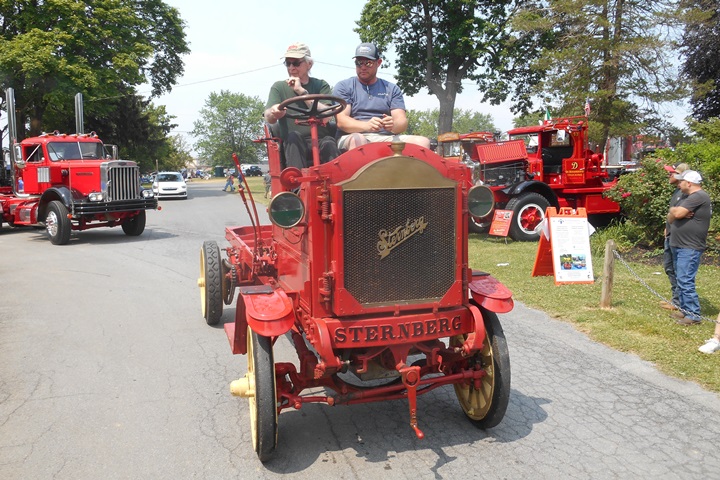
How cool is this?
Sterling truck enthusiast and historian Warren Richardson is driving the
oldest known Sterling, a 1914 Sternberg 2-ton truck. Warren has
been instrumental in providing information and photos for the page.
The Sternberg is owned by the Nuss Collection in Minnesota. Steve
Skurnowicz photo via Jeff Lakaszcyck from the 2023 Macungie truck show.
Image added 1-17-2024.
The
White Motor Company purchased Sterling on June 1, 1951. Sterling
then became the Sterling-White Division of the White Motor Company, and
all Sterling trucks were supposed to have been produced under the name
Sterling-White. However, some of the trucks may have been built as Sterlings
right after the purchase. On July 1, 1953, all production was moved from
Milwaukee to the White plant in Cleveland. By the end of 1953,
Sterling-White production had ceased, although existing orders for
Sterling-White trucks were built until early 1954. Sterling
and Sterling-White had also been building crane carriers for
Bucyrus-Erie. Existing orders for these trucks continued until
1957-58.
Freightliner resurrected the Sterling
name on a series of Class 8 trucks
built from 1997 to 2009.
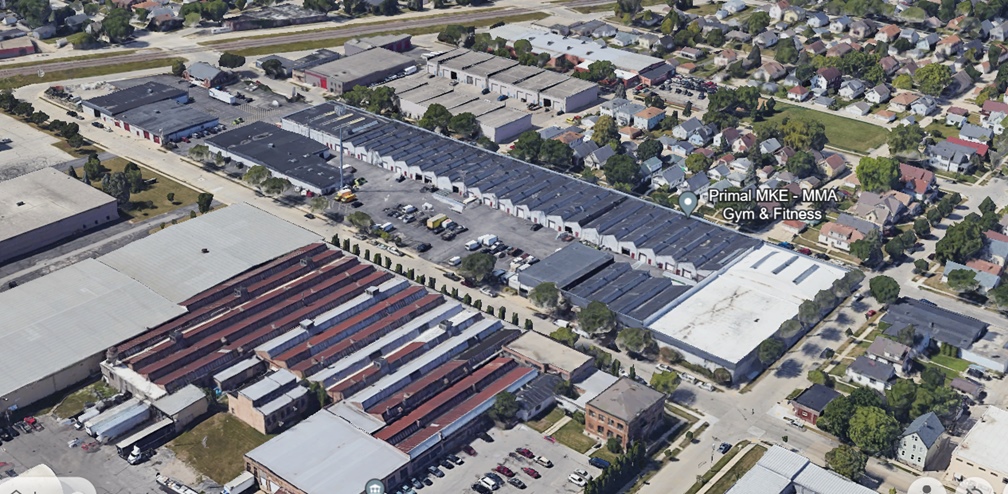
The former Sterling
Motor Truck Company factory still exists today as the West Allis
Commercial Center and is the long series of buildings in the center of
the photo. The two story green house in the lower left corner is
part of the Sterling story as is the two story brown brick building at
the bottom of the photo. Their significance will be explained in
the narrative below. Google Earth satellite view added 2-6-2024.
World War One: Sterling was one of fifteen companies that built
9,364 standardized Class B Standard 4x2 Trucks, commonly known as
Liberty trucks, for the U.S. Army in 1917-1918. Sterling built 479
Liberty trucks.
The two
pages below are from the March 1918 issue of "The Motor Truck." This
provides invaluable information that reveals the types, volume, and
suppliers of motor vehicles and components that the U.S. Army
Quartermaster contracted for use in World War One. The document shows
that Sterling was originally contracted for 500 Liberty trucks.
With the end of the war in November 1919, the contract was terminated at
479 units.
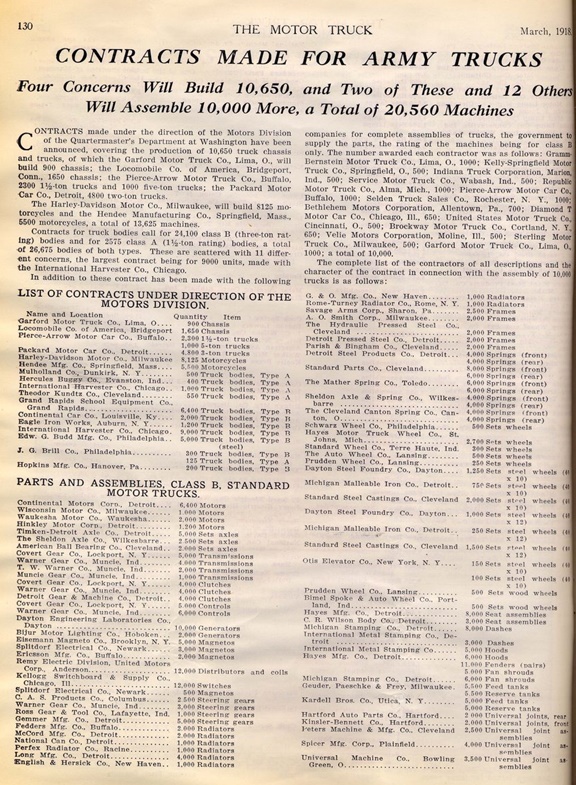
Document courtesy of Warren Richardson added
11-13-2020.
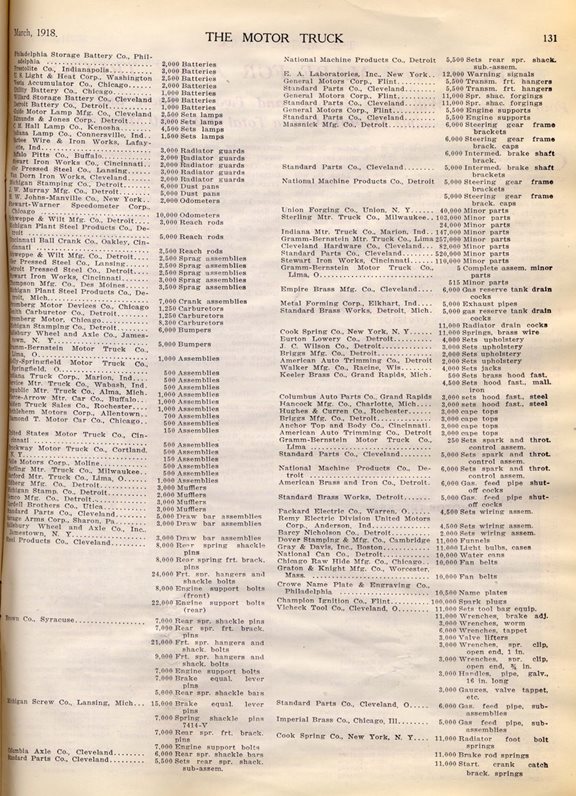
Sterling is listed twice on this page.
First, Sterling is listed in the left-hand column for the contracted 500
trucks, and secondly in the upper right-hand corner for parts.
There is one line
item with two entries for 102,000 and 24,000 respectively for "minor parts." Document courtesy of Warren Richardson added
11-13-2020.
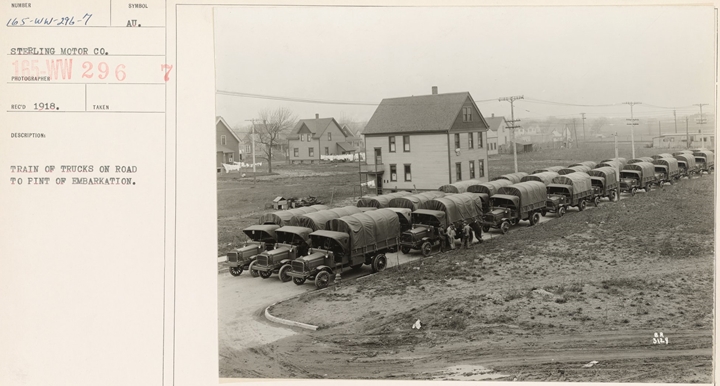
These two 1918 photos
show nine rows of three Sterling Liberty trucks each, lined up in a partially
developed residential area of Milwaukee, WI. Several of the
Sterling Motor Truck Company employees can be seen talking, standing next to the nearest truck
in the second row. Something not seen much anymore is laundry
drying on clotheslines at two houses in the background. Photo from
the National Archives.
The two story house in
the photo still exists and has a current address of 1965 South 54th
Street in West Allis, WI. In 1918 the house was located on South
45th Street. The Sterling Motor Truck plant was on the same side
of the street and the one block south of the house. This photo
was taken from the top of the roof of the Kempsmith Manufacturing
Company's office building.
For more detailed
information on the above photo and the location of the Sterling Motor
Truck Company's factory, refer to the
"The Sterling Motor Truck Factory in West
Allis, WI" section near the bottom of this page.
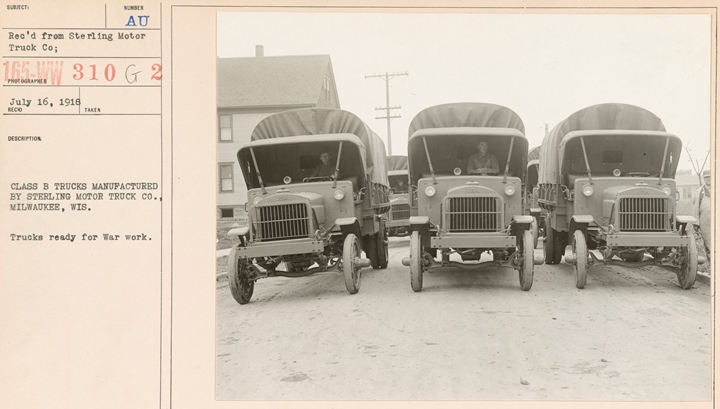
This photo shows a
closer view of the trucks with most employees at the wheel, with the exception of the one
truck on the right.
These photos were taken on July 16, 1918. There were two series of
Standard B trucks. These trucks are of the first series because they have
electrical lighting. Wires for the electrical current have been
routed from holes below the headlights. The second series
eliminated the electrical lighting and the associated battery,
distributor, and generator. Photo from the National Archives.
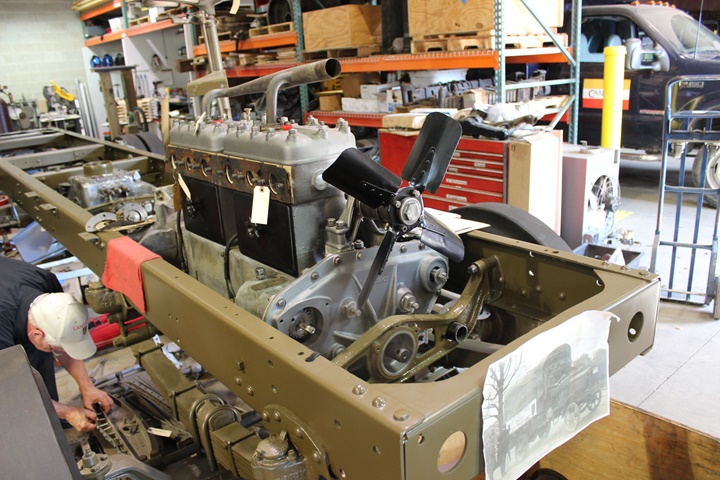
In 2015 this World War One Liberty truck
chassis and drive train were undergoing restoration at the First
Division Museum in Wheaton, IL. This restoration is not
specifically associated with any of the fifteen companies that built the
Liberty truck because the parts are from various sources. Author's
photo.
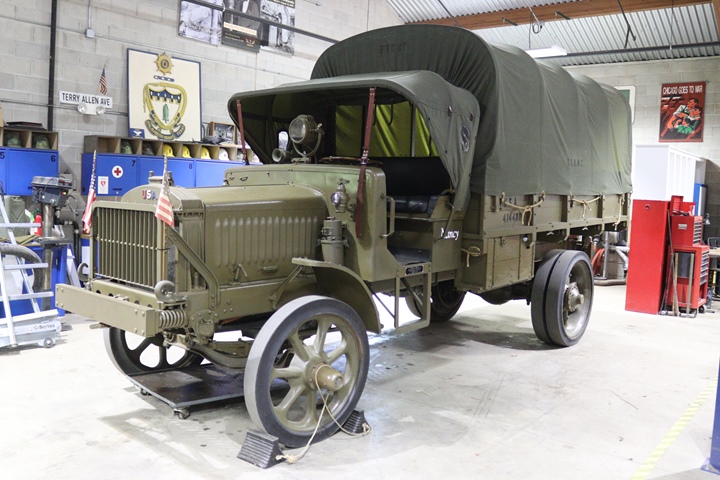
This is the completed Standard B Liberty
truck. It is the second series as photographed in 2019. The electrical headlights have
been replaced with oil wick lamps. A carbide gas spot light used
as a driving light is mounted on the top of the firewall. This
vehicle has been restored to operating condition and is driven around
the First Division Museum complex on special occasions.
Author's photo.
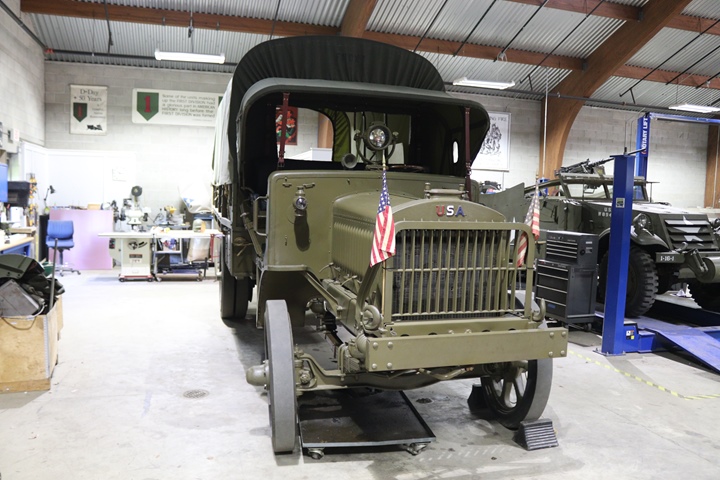
Author's photo.
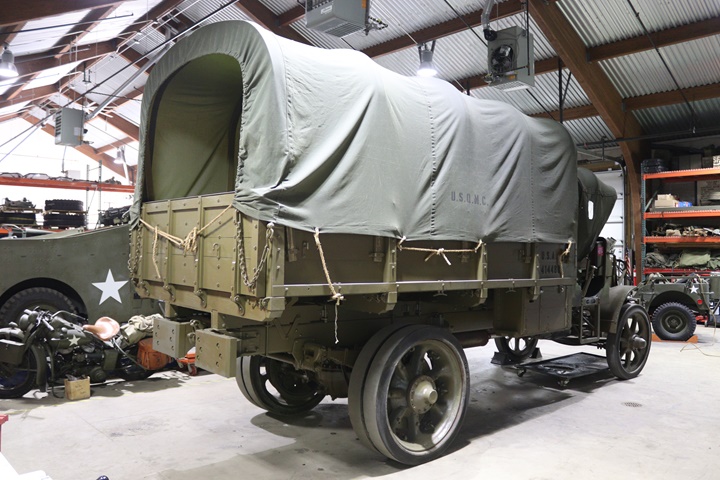
Author's photo.
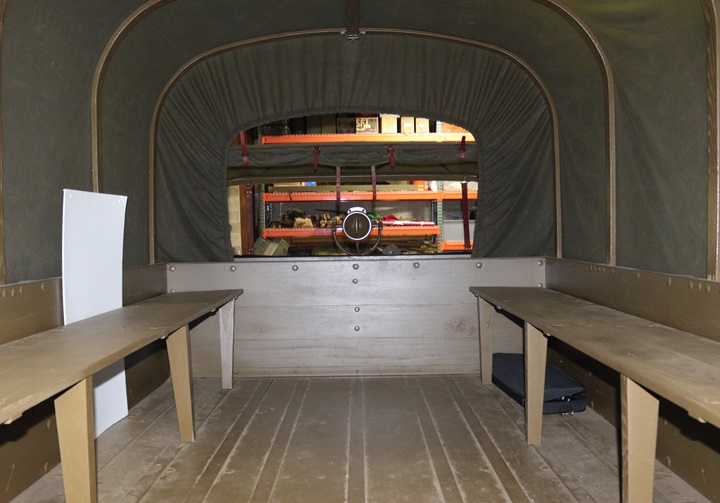
Author's photo.
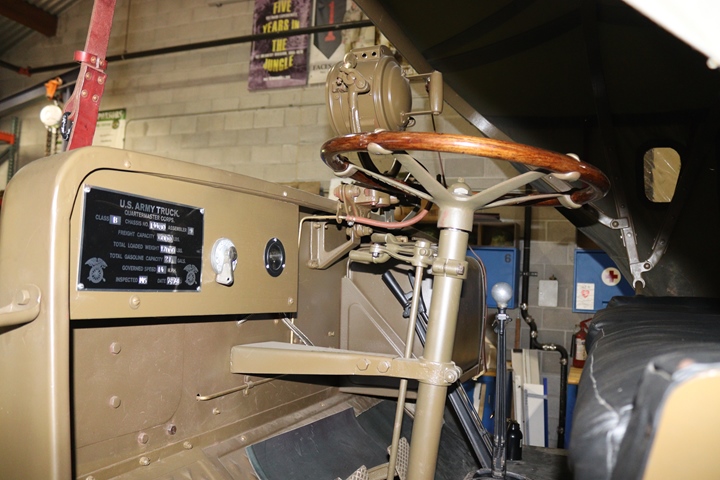
The copper tube from the gas generator can be seen coming out of the fire wall and being routed
to the spotlight. A flexible rubber hose at the spot light allows it
to be aimed by the assistant driver. Author's photo.
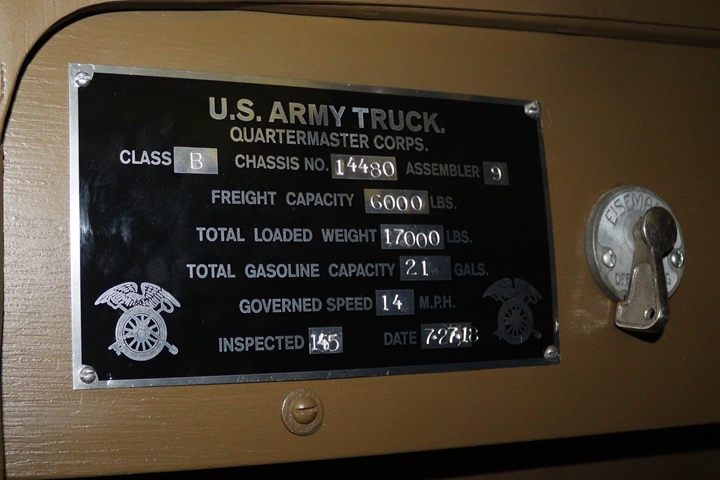
The replica data plate shows the vehicle
having chassis no. 14480 and a date of 7-271918. Author's photo.
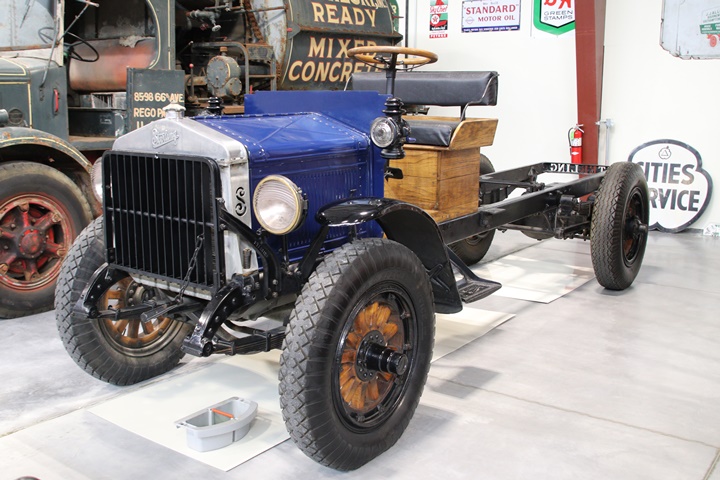
This 1923 Sterling on
display at the Iowa 80 Trucking Museum has an interesting story.
Originally it had a dump body on it. In 1931, Mr. Frank Oulicky
purchased it and the truck moved Mr. Oulicky and his wife and their
belongings on a 16 day sojourn to the gold fields of California.
The truck only had a top speed of 22 mph. Author's photo added
1-12-2024.
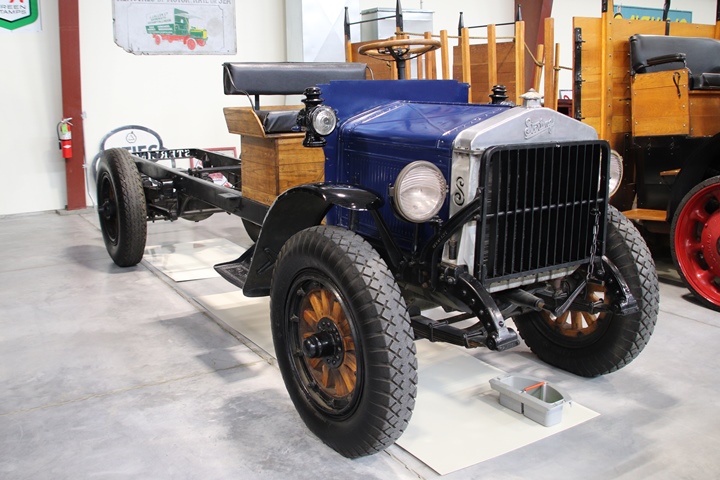
Author's photo added
1-12-2024.
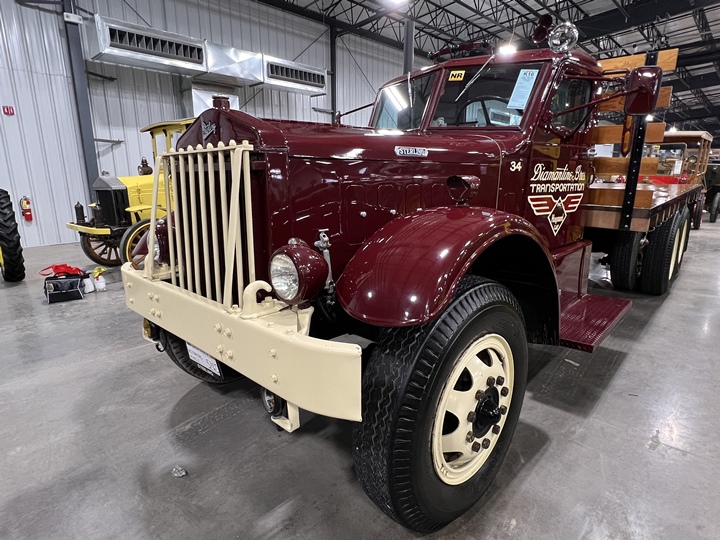
This classic looking
Sterling HWS160 was photographed by Tim Wright at a 2022 Mecum auction.
This has been identified as being built in either 1943 or 1944.
Photo courtesy of Tim Wright added 1-17-2024.
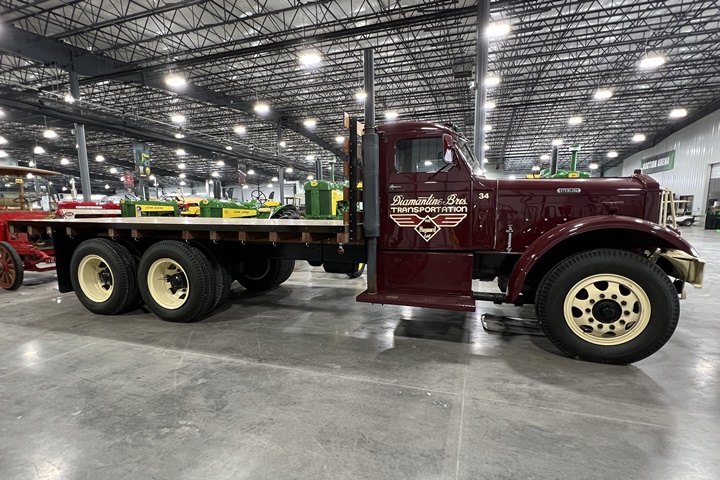
Photo courtesy of Tim Wright added 1-17-2024.
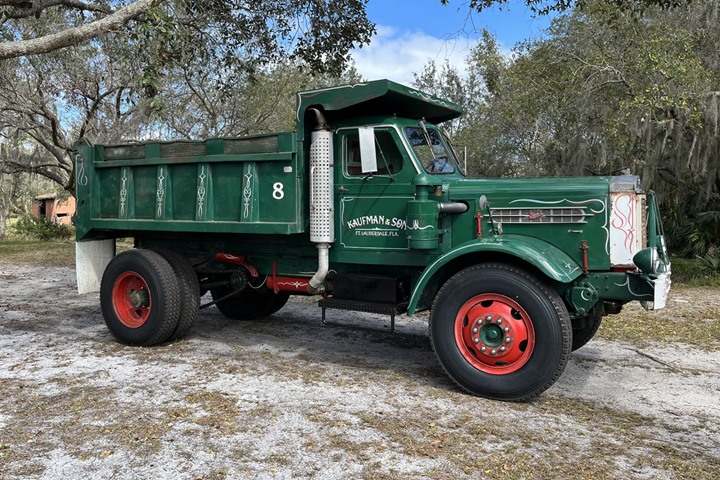
Vintage Sterling trucks are rare and hard to
find. In July 2022, Jeff Lakaszcyck was able to locate and
purchase this great looking 1950 Sterling HB2002D. This vehicle is
equipped with a
Cummins
HRBBD600 diesel engine. Photo
courtesy of Jeff Lakaszcyck added 1-17-2024.
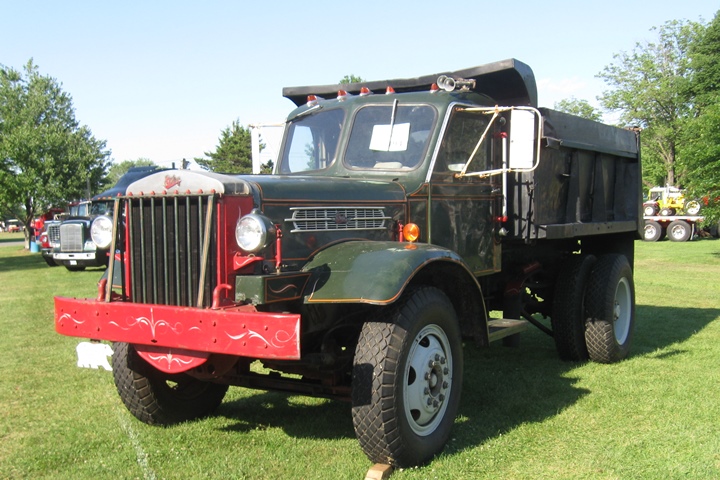
How cool is this? Sterling historian
and collector Warren Richardson also owns a 1950 Sterling HB2002 dump
truck. His truck is powered by a Waukesha 145GK gasoline engine.
Photo courtesy of Jeff Lakaszcyck added 1-17-2024.
Sterling Motor Truck
Company World War Production: Table 1 shows that the Sterling
Motor Truck Company was awarded
$10,549,000 in major contracts during World War Two.
Outside of the information contained in Table 1, information on the number of
different types of trucks that Sterling built for the war effort is
sparse. Sterling supplied the U.S. Army Corps of Engineers, the
United States Army Air Force, and the U.S. Navy. More complete
military purchasing records for these products during World War Two are not
available. Also, Sterling corporate records were lost when the
company was purchased by White Motors in 1951. Therefore, any information
on the number of trucks the company built is limited. The
information supplied in Table 3 has been provided by truck historians
Warren Richardson and Jeff Lakaszcyck. Without their assistance
and knowledge, this page on the Sterling Motor Truck Company's
contribution to winning World War Two would not have been possible.
They have also provided many of the photos used on this page.
Table 1 - Sterling Motor Truck Company's
Major World War Two Contracts
The information below
comes from the "Alphabetical Listing of Major War Supply
Contracts, June 1940 through September 1945." This was
published by the Civilian Production Administration,
Industrial Statistics Division, Requirements and Progress
Branch January 21, 1946. Table added 1-12-2024. |
|
Product - Customer |
Contract Number |
Contract Amount |
Contract Awarded
|
Completion
Date |
| Truck
Tractors - Army Corps of Engineers |
1098-ENG-34L |
$63,000 |
8-1941 |
10-1941 |
| Trucks Motor
- Army Corps of Engineers |
1098-ENG-251 |
$48,000 |
9-1941 |
10-1941 |
| Construction
Equipment - Army Corps of Engineers |
1098-ENG-00455L |
$461,000 |
1-1942 |
6-1942 |
| Trucks - Army
Corps of Engineers |
1098-ENG-451L |
$244,000 |
1-1942 |
3-1942 |
| Truck Parts -
Army Corps of Engineers |
414-ENG-1888 |
$55,000 |
3-1942 |
6-1942 |
| Trucks - Army
Corps of Engineers |
1098-ENG-17200L |
$66,000 |
7-1942 |
11-1942 |
| Trucks - Army
Corps of Engineers |
1098-ENG-2254 |
$51,000 |
9-1942 |
9-1942 |
| Trucks
Tractor - Navy |
NXS-17444 |
$3,115,000 |
11-1942 |
10-1943 |
| Trucks - Army
Corps of Engineers |
1122-ENG-1186 |
$888,000 |
12-1942 |
6-1943 |
| Truck
Tractors - Navy |
XS0-22612 |
$156,000 |
1-1943 |
6-1943 |
| Tractor
Trucks - Navy |
NXS-25814 |
$144,000 |
3-1943 |
9-1943 |
| Crane Trucks
- Navy |
NXS-29108 |
$1,108,000 |
5-1943 |
3-1944 |
| Tractors -
Navy |
NXS-33528 |
$320,000 |
6-1943 |
2-1944 |
| Cargo Dump
Trucks - Navy |
NXS-34652 |
$238,000 |
9-1943 |
3-1944 |
| Trucks - Navy |
NXS-37086 |
$281,000 |
9-1943 |
12-1943 |
| Motor Truck
Chassis - Navy |
XSA-56661 |
$364,000 |
1-1944 |
10-1944 |
| Ind Truck
Motor Parts - Navy |
XS0-49334 |
$77,000 |
2-1944 |
7-1944 |
| Truck Chassis
Cabs - Navy |
NXS-51085 |
$183,000 |
2-1944 |
9-1944 |
| Truck Parts -
Army Corps of Engineers |
47013-ENG-509 |
$70,000 |
3-1944 |
5-1945 |
| Tractors -
Navy |
XSA-62816 |
$290,000 |
4-1944 |
3-1945 |
| Truck Chassis
- Navy |
XSA-67686 |
$1,513,000 |
5-1944 |
6-1945 |
| Trucks - Army
Ordnance |
11022-ORD-5231 |
$56,000 |
9-1944 |
6-1945 |
| Trucks T28 -
Army Ordnance |
11022-ORD-5232 |
$56,000 |
9-1944 |
6-1945 |
| Trucks - Army
Ordnance |
11022-ORD-5567 |
$57,000 |
10-1944 |
7-1945 |
| Trucks - Army
Ordnance |
11022-ORD-8756 |
$54,000 |
4-1945 |
2-1946 |
| Trucks - Army
Ordnance |
11022-ORD-8976 |
$54,000 |
4-1945 |
2-1946 |
| Trucks - Army
Ordnance |
11022-ORD-8789 |
$108,000 |
4-1945 |
2-1946 |
| Trucks - Army
Ordnance |
11022-ORD-8975 |
$66,000 |
4-1945 |
2-1946 |
| Trucks - Army
Ordnance |
11022-ORD-8977 |
$64,000 |
4-1945 |
2-1946 |
| Trucks - Army
Ordnance |
11022-ORD-8974 |
$66,000 |
4-1945 |
2-1946 |
|
Wrecker Trucks - Army Ordnance |
11022-ORD-9518 |
$78,000 |
6-1945 |
2-1946 |
| Tractor
Trucks - Army Ordnance |
11022-ORD-9528 |
$155,000 |
6-1945 |
5-1946 |
| Total |
|
$10,549,000 |
|
|
Table 1 shows us that
the Army Corps of Engineers was Sterling's main military customer with
contracts awarded between August 1941 through December 1942.
Starting in November 1942 and running through June 1945, the U.S. Navy was
Sterling's main customer. Table 2 shows that the U.S. Navy kept
Sterling alive during World War Two, as it procured $7,789,000 trucks and
parts. This was 73.8% of Sterling's military business during World
War Two. Beginning in September 1944, Army Ordnance awarded
Sterling eleven contracts worth $814,000 for work on experimental trucks
that were not finished until 1946. However, Sterling was still
working on Navy and Army Corps of Engineer's contracts through the
middle of 1945.
Table 3 shows that the USAAF purchased 126 trucks. However, there are no major contracts
representing the Army Air Force's purchases. It may well be these
were purchased by the Army Corps of Engineers for the USAAF.
Table 1 shows that the
U.S. Navy awarded Sterling contract NXS-29108 for crane trucks.
The value of this contract was $1,108,000 Table 3 shows that the Navy
procured 100 DDS150 torpedo crane trucks. If this was the only
contract for the crane trucks, the individual cost was $11,080
each.

This data plate from Sterling DDS235 serial
number 602 shows that it was built under Navy contract NXSA-17444.
Table 1 shows that the value of this contract was $3,115,000.
There were a total of 290 DDS235s built for the U.S. Navy during World
War Two. The unit cost for each one was $10,741. Photo
courtesy of Warren Richardson added 1-17-2024.
If the Navy contracts
for parts and cabs is subtracted from $7,789,000, the result is
$7,529,000. Table 3 shows that the U.S. Navy purchased 504 trucks.
The 504 Navy trucks had an average cost of $14,938 each.
Table 2 - Sterling Motor Truck Company's
Major World War Two Contracts by Customer
Table added 1-12-2024. |
|
Customer |
Contract Value |
Percentage |
|
Navy |
$7,789,000 |
73.8% |
|
Army Corps of Engineers |
$1,946,000 |
18.4% |
|
Army Ordnance |
$814,000 |
7.7% |
|
Total |
$10,549,000 |
99.9% |
Table 3 - Sterling
Motor Truck Company World War Two Production
Most of the information below was provided by Warren
Richardson and Jeff Lakaszcyck. |
| Model
Number |
Type |
Capacity |
Engine |
Known Quantity |
Known Serial Numbers |
Known Dates of Production |
Customer
|
Comments |
|
MC96 |
4x2 Chain Drive |
|
|
4 |
|
1940 |
Nick F
Helmers and McWilliams Dredging |
These
were used by the civilian contractor to build the USAAF bases
in the North Atlantic during World War Two. |
|
HC144 |
4x2 Chain Drive |
7-11 Tons |
Waukesha 6SRKR |
5 |
144HC617-619, 144HC679, 144HC6148 are known |
1940, 1943 |
US
Navy |
There
may be more than the five identified serial numbers. These
are the only ones that historians have been able to
find. Historians have also found production dates in 1940
and 1943. There may be others. |
|
HC145 |
4x2 Chain Drive |
7-11 Tons |
Waukesha 6SRKR |
18 |
145HC680 and 145HC6101 |
1940
|
George
Fuller, Merritt, Chapman & Scott |
These
were used by the civilian contractor to build the USAAF bases
in the North Atlantic during World War Two. There are
sixteen known derelict HC145s at a former USAAF base in
Greenland. These were used by civilian contractors to
build the base during World War Two. |
| HC165 |
4x2 Chain Drive |
8-12
Tons |
Waukesha 6SRKR (in trucks used by USN) |
6 |
165HC663 and 165HC680- 684 |
1943
|
U.S. Navy Bureau of Yards & Docks |
Five tractors
were purchased by the Navy Bureau of Yards & Docks. It is assumed that the
Serial Numbers 165HC680- 684 were the five shipped to the Navy.
|
|
HC105 |
4x2 Chain Drive |
|
|
1 |
|
|
USAAF |
The
HC105 model was built into Class 750 fire
trucks with a covered cab. |
| HD105 |
4x2 Drive Shaft |
|
Hercules WXLC3 |
25
|
105HD618 to 105HD643 |
1942 |
USAAF |
Howe Fire Apparatus built at
least one into a Class 750 fire truck with an open cab. |
| |
|
|
|
|
|
|
|
|
| DD115 |
4x4 Drive shaft |
|
Waukesha 6SRKR |
50 |
115DD629 through 115DD678 |
|
U.S. Navy |
Four are still known to exist. |
| |
|
|
|
|
|
|
|
|
|
HCS297 |
6x4 was a dual chain drive |
15-20 Tons |
Waukesha 145GK |
|
|
|
|
|
|
HWS160H
|
6x4 with enclosed drive |
8-12 Tons |
Cummins Diesel |
1 |
|
|
U.S.
Army |
One
was USA 0063654. |
|
|
|
|
|
|
|
|
|
|
|
DDS150 |
6x6 enclosed drive |
42,000 lbs. GVW |
Waukesha 6SRKR |
100 |
|
1943, 1945 |
U.S. Navy |
Torpedo crane truck. |
|
DDS225 |
6x6 enclosed drive |
|
Waukesha 6WA |
100 |
|
|
USAAF |
Cardox 150 enclosed cab fire crash
truck was purchased by the
Army Air Corps. |
|
DDS235 Cardox |
6x6 enclosed drive (drive shaft) |
48,000 GVW from cab plate |
Waukesha GK145 OHV gasoline engine |
40 |
Known
Serial numbers are 235DDS6251 to 235DDS6290. |
|
U.S. Navy |
Navy Registration Numbers 86782-86821
Cardox Serial numbers for this series of
trucks is 1229-1268.
One of at least two known
surviving DDS235s is 235DDS6287
that is located at the
Historical Construction
Equipment Association in Bowling Green, OH. See photo below.
Another is owned by a
private owner in VA. See photo below. |
|
DDS235 Wrecker |
6x6 enclosed drive (drive shaft) |
48,000 GVW from cab plate |
Waukesha GK145 OHV gasoline engine |
250 |
235DDS601-6250 Inclusive
|
1943 |
U.S. Navy |
Aircraft crash recovery vehicle. |
|
HCS330
|
6x6 dual chain
|
80,000 GVW from cab plate |
Waukesha GK145 OHV gasoline engine |
56 |
330HCS610 to the highest is 330HCS665
Inclusive |
1945 |
U.S. Navy |
This aircraft
recovery vehicle was used by the U.S. Navy for its bigger aircraft. |
| DDS??? |
6x6 |
|
|
2 |
|
1942 |
U.S. Navy |
This is described U.S. Navy literature as
a Low Boy Tractor. It has an extended cab. |
|
Total Trucks |
|
|
|
633 |
|
|
|
|
| |
|
|
|
|
|
|
|
|
| T26 |
8x8 |
20 Ton |
American LaFrance V12 275 HP |
1 |
|
Jan -
May 1946 |
US Army Ordnance Division |
This was originally built as a cargo
carrier and then converted into a tractor.
|
| T26E1 |
8x8 |
20 Ton |
Ford GAA V8 525 HP |
3 |
|
|
US Army Ordnance Division |
This model was built in both the
cargo and tractor configurations. |
| T26E2 |
8x8 |
20 Ton |
Ford GAA V8 525 HP |
2 |
|
|
US Army Ordnance Division |
This model was built in the wrecker
configuration. |
| T26E3 |
8x8 |
20 Ton |
Ford GAA V8 525 HP |
1 |
|
|
US Army Ordnance Division |
This could have been built as either
a cargo carrier or a tractor. This was equipped with a
Fuller 5M920 five-speed transmission. |
| T26E4 |
8x8 |
20 Ton |
Ford GAA V8 525 HP |
1 |
|
|
US Army Ordnance Division |
This could have been built as either
a cargo carrier or a tractor. This was equipped with a
Fuller 5A920 five-speed transmission with a hydraulic converter. |
| T27E1 |
6x4 Chain Drive |
|
Hercules HXD (white 666 chassis) |
1 |
|
|
US Army Ordnance Division |
White 666 with
a dual chain
drive bogie mounted by Sterling. |
| T28 T28E2 |
6x6 |
55,000 GVW |
Continental X6820 820 cubic inch
OHV 320 HP |
4 |
|
June - Sept 1945 |
US Army Ordnance Division |
One T28 Cargo Unit, One T28
Tractor, Two T28E2 Tractors |
| T29 T29E1 |
6x6 |
25
Ton, 225,000 GTW |
Ford
GAA V8 engines (1100 cubic inch displacement, 525 HP) |
2 |
|
July
1945 |
US Army Ordnance Division |
T29E1
never built - re-designated as T46 |
| T35 |
6x6 |
25
Ton, 335,000 GTW |
Ford
GAC V12 engines (1649 cubic inch displacement, 770 HP) |
1 |
T 351 |
Jan
1946 |
US Army Ordnance Division |
Dual
Chain Drive rear with shaft driven double reduction front axle |
| T35E1 |
6x6 |
25
Ton, 335,000 GTW |
Ford
GAC V12 engines (1649 cubic inch displacement, 770 HP) |
1 |
|
Jan
1946 |
US Army Ordnance Division |
Planetary double reduction rear axles with double reduction
front axle |
| T46 |
6x6 |
25
Ton, 85,000 GVW, 335,000 GTW |
Ford
GAA V8 engines (1100 cubic inch displacement, 525 HP) |
1 |
T 461 |
Sept
1946 |
US Army Ordnance Division |
From
T29E1 with increased capacity |
|
Total Experimental Trucks |
|
|
|
18 |
|
|
|
|
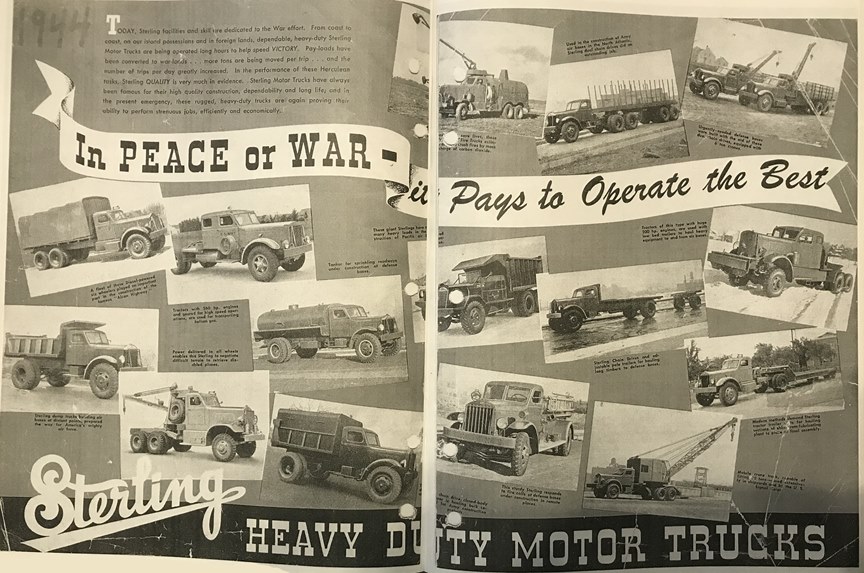
These two pages are from the 1944 booklet
"Sterling at War." Image courtesy of Jeff Lakaszcyck
added 11-13-2020.
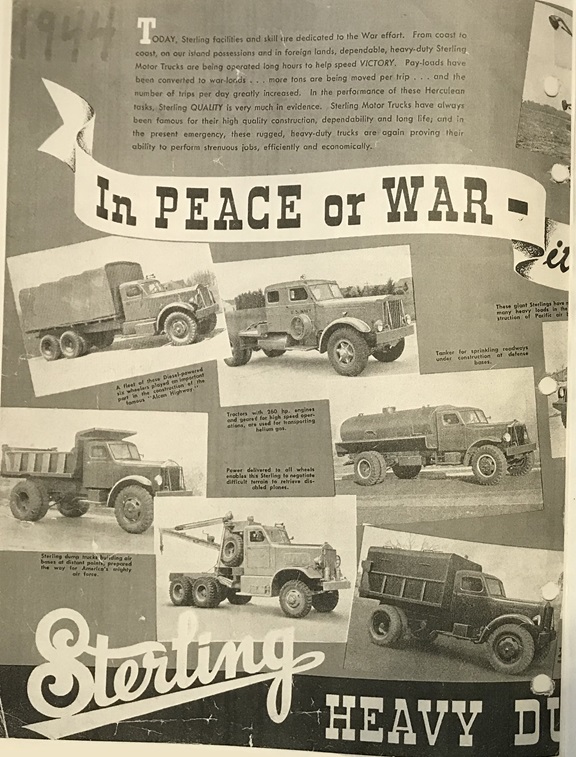
Image courtesy of Jeff Lakaszcyck
added 11-13-2020.
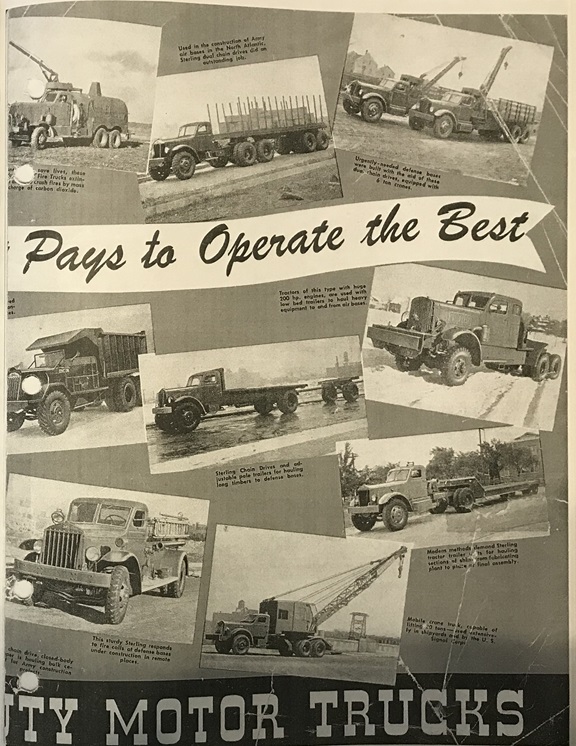
Image courtesy of Jeff Lakaszcyck
added 11-13-2020.
Photos:
Various models as shown below.
The DDS150, DDS225, and DDS235
were the only models specifically built for military use. The
HCS330 was highly modified for its use as a military truck. For
the military version the frame was 50% deeper, the suspension was
changed, and the sheet metal for the hood and fenders were modified.
It was almost a different vehicle. The others were civilian models
adapted for the military use.
4x2:
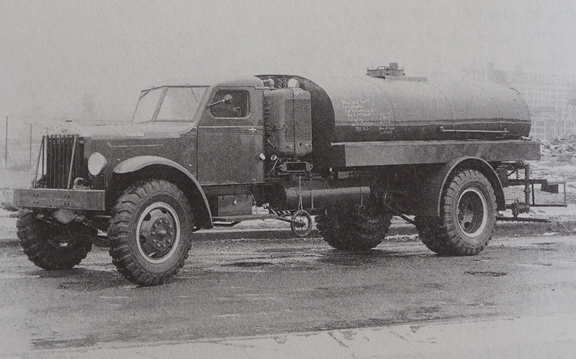
The Sterling HC145 4x2 Chain Drive was
outfitted for coating gravel roads with dust reducing oil. They
were used by the Army Corps of Engineers for the construction of airbases
in the North Atlantic. Greenland and Iceland are two locations in
the North Atlantic where Army Aviation Battalions built airbases during
World War Two.
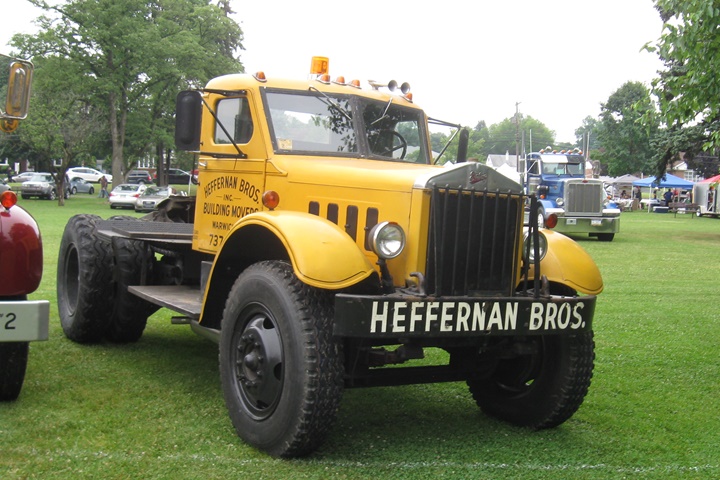
This
1944 HC165 4x2 is one of five that were purchased by the U.S. Navy
during World War Two. Image courtesy of Jeff Lakaszcyck.
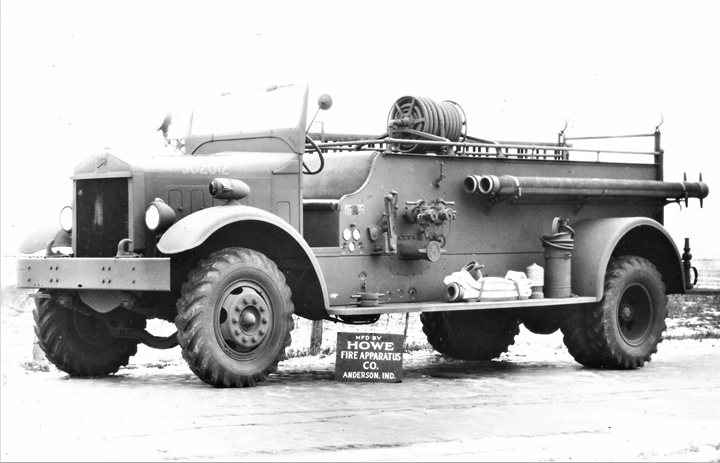
This
1942 Sterling HD105 4x2 Class 750 fire truck served at Lewiston AAF
Base, MT during World War Two. Image courtesy of Warren
Richardson added 11-13-2020.
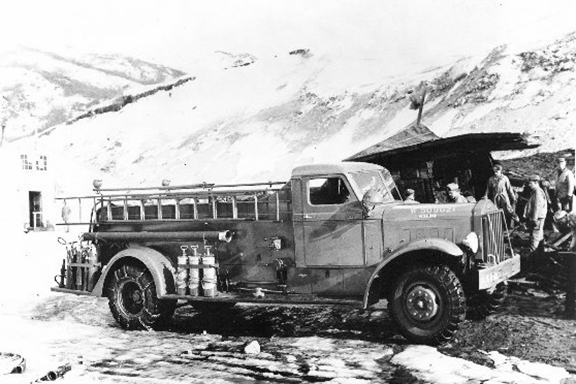
This Sterling HC105 was on duty in the Aleutian
Islands during World War Two.
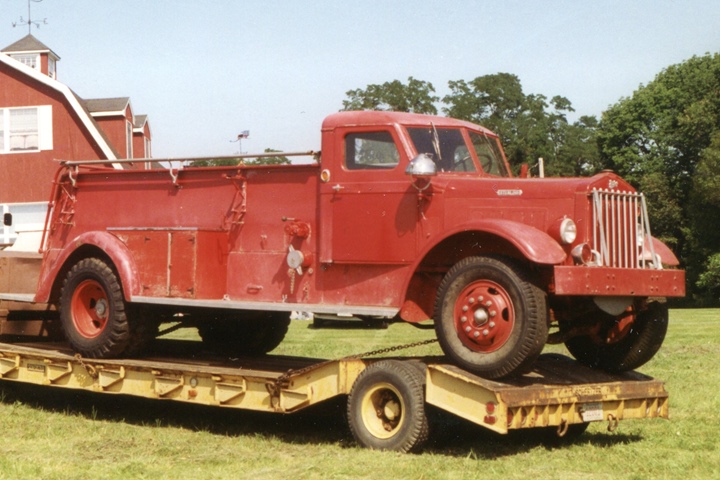
This Sterling HC105 with serial number 641.
Image courtesy of Warren Richardson added 11-13-2020.
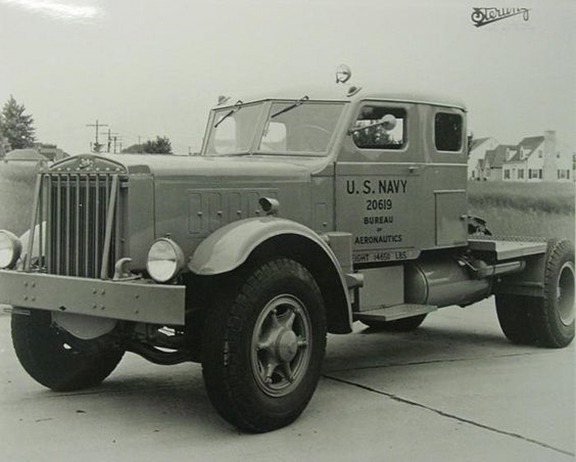
Sterling also built this extended cab tractor for the U.S. Navy, which
used it to pull loads between Naval Air Stations. Image added
1-28-2024.
4x4:
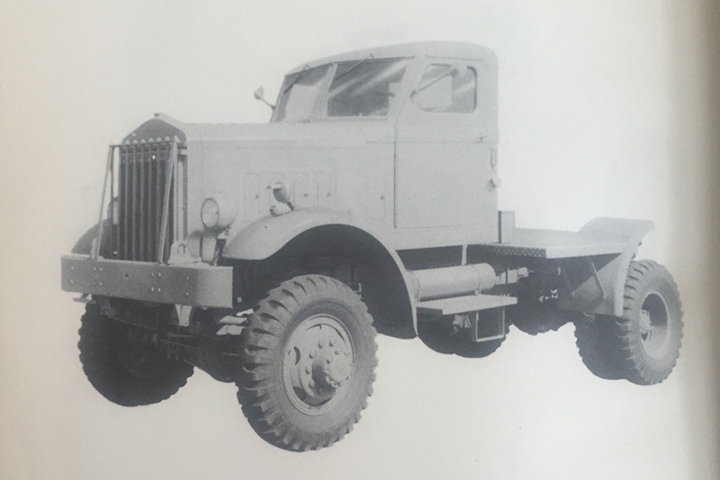
Fifty
DD115 4x4s were purchased by the U.S. Navy. Image courtesy of
Warren Richardson added 11-13-2020.
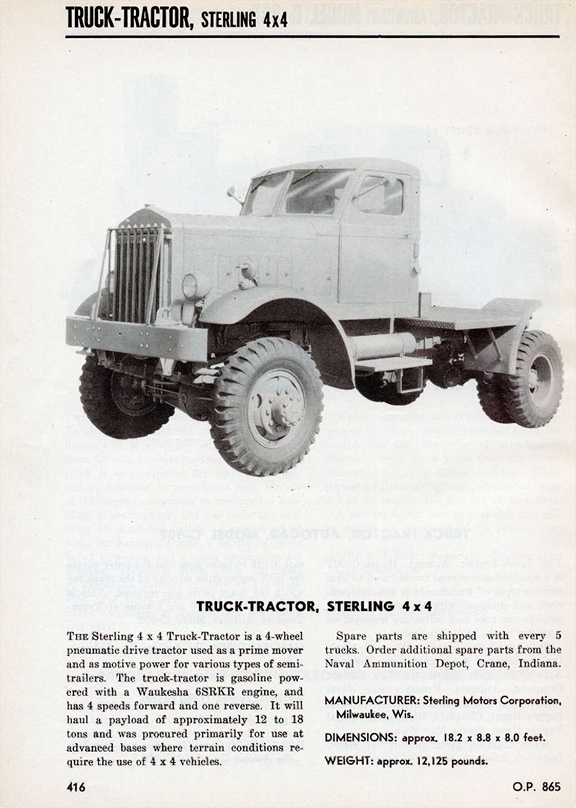
The previous photo and the one on this
page from U.S. Navy Ordnance Pamphlet 865 are the same. However,
the one from O.P. 865 tells how and where the DD115 was used by the
Navy. Table 4 shows that the Navy procured 50 DD115s for use at
advance bases during World War Two. O.P. 865's full title is
Aviation Ordnance Equipment Catalog and shows all of the equipment
needed by a Naval Aviation unit to operate and keep its aircraft in
flying condition. No doubt the Sterling DD115s were present and
pulling trailers to keep such Navy aircraft at the F4U Corsairs
operating from island bases in the Solomon Islands. Image added
1-12-2024.
6x4:
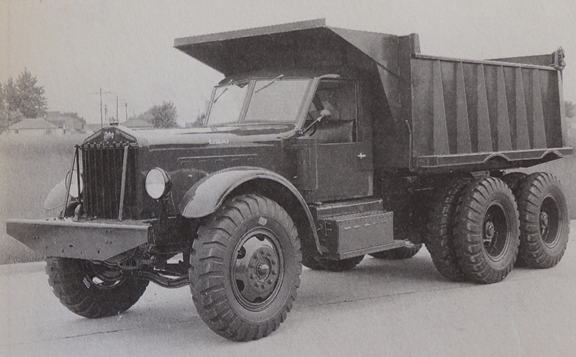
The Sterling HCS297 6x4 was a dual chain
drive dump truck. It was used for airbase construction in the
North Atlantic.
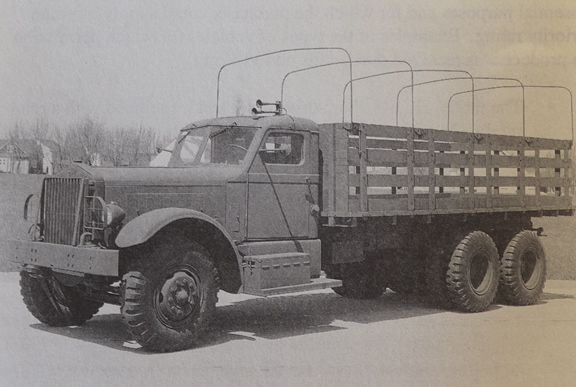
The Sterling HWS160H 6x4 with a drive shaft
and differentials came with a stake body. It was powered by a
Cummins Diesel HB engine and utilized by the Army Corps of Engineers.
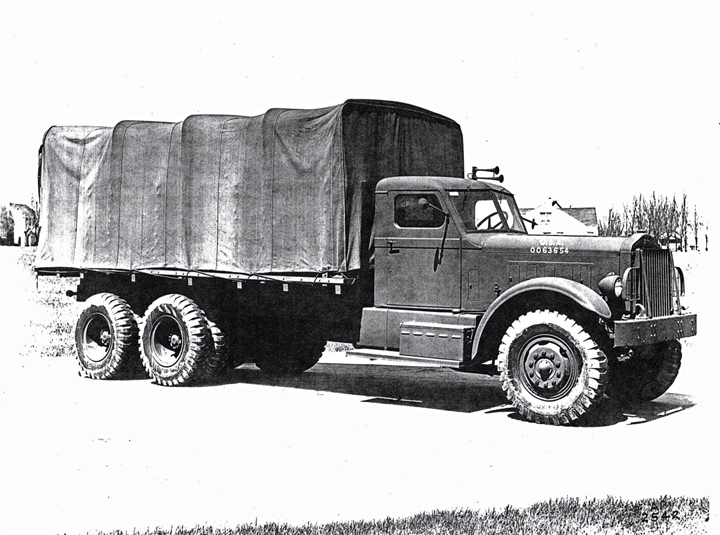
This
HWS-160 is USA 0063654. Photo courtesy of Jeff Lakaszcyck
added 11-13-2020.
6x6:
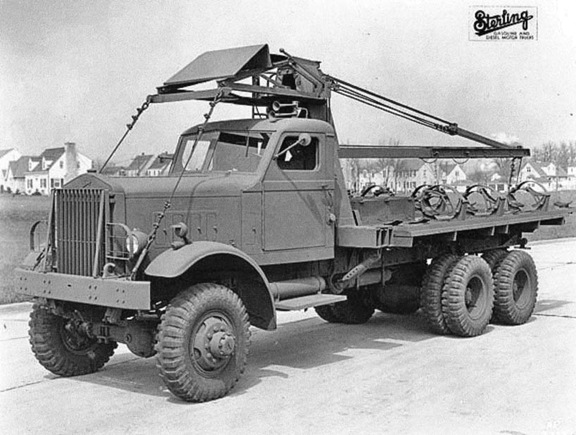
Sterling built the DDS150 6x6 enclosed drive
torpedo crane truck for the U.S. Navy. Note the bracket on the bed
for tying down the torpedoes.
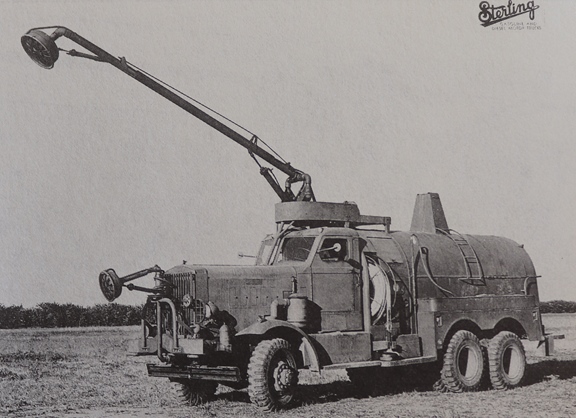
The Sterling DDS225 6x6 enclosed cab fire
crash rescue truck was purchased by the Army Air Corps. The one pictured above has
a Cardox fire suppression system. Sterling provided chassis and cab, and
Cardox added the rest of the equipment. It was powered by a
Waukesha 6WA gasoline engine.
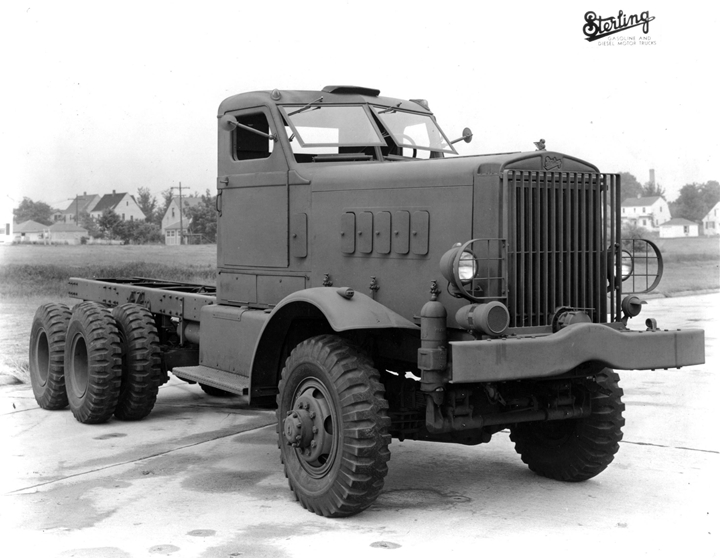
This is a Sterling DDS225 6x6 before the
Cardox unit was added. Photo courtesy of Jeff Lakaszcyck
added 11-13-2020.
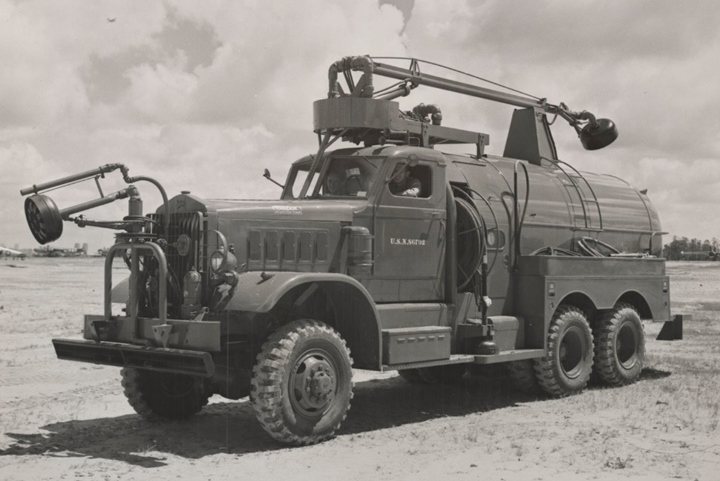
This is a Sterling DDS 235 USN Cardox crash truck. Photo
courtesy of Jeff Lakaszcyck
added 11-13-2020.
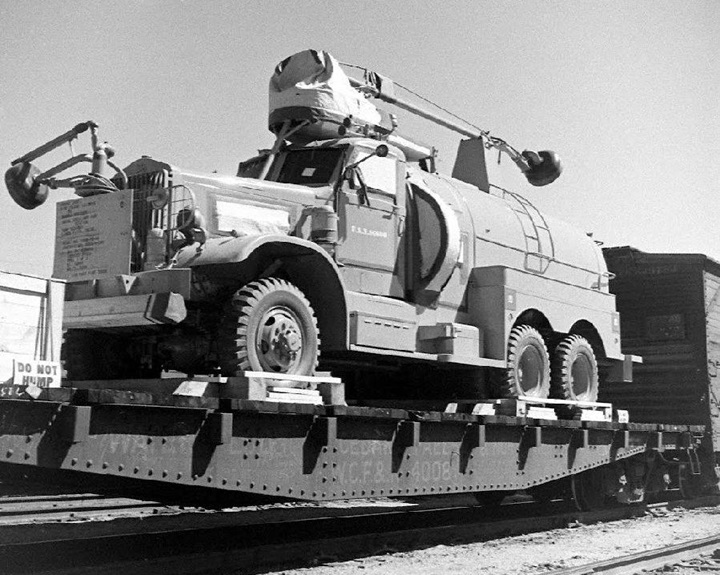
This is another Sterling DDS 235 USN Cardox crash truck.
Photo courtesy of Jeff Lakaszcyck
added 11-13-2020.
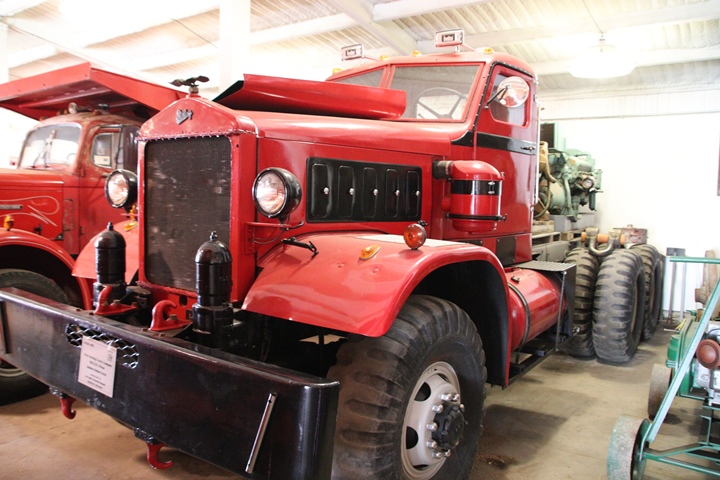
This
DDS235 is part of the collection of the Historical Construction
Equipment Association at Bowling Green, OH. The information
placard notes that it is a 1946 model of the DDS235. However,
information provided by
Jeff Lakaszcyck identifies this truck as one
of the 40 DDS235 Cardox trucks built for the Navy during World War Two.
Most likely it was considered military surplus at the end of the war and
then sold on the civilian market in 1946. This truck is serial
number 235DDS6287 as shown in the photo below.
Author's photo added 1-12-2024.
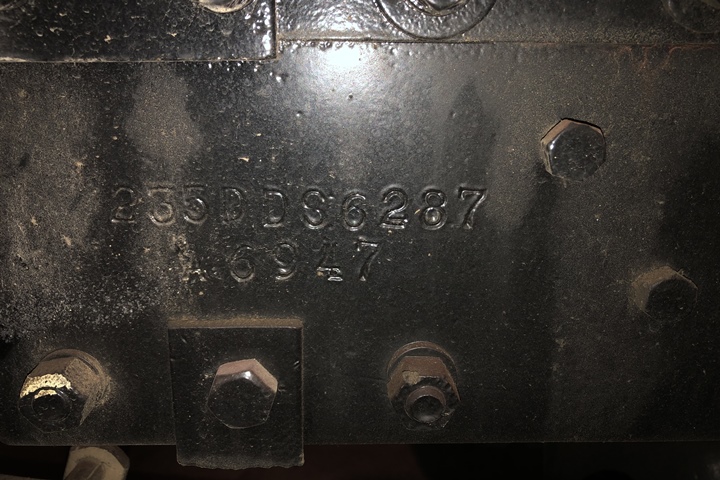
This photo of the serial number on the frame
identifies this as a World War Two truck. Photo provided by Jeff Lakaszcyck
added 1-17-2024.
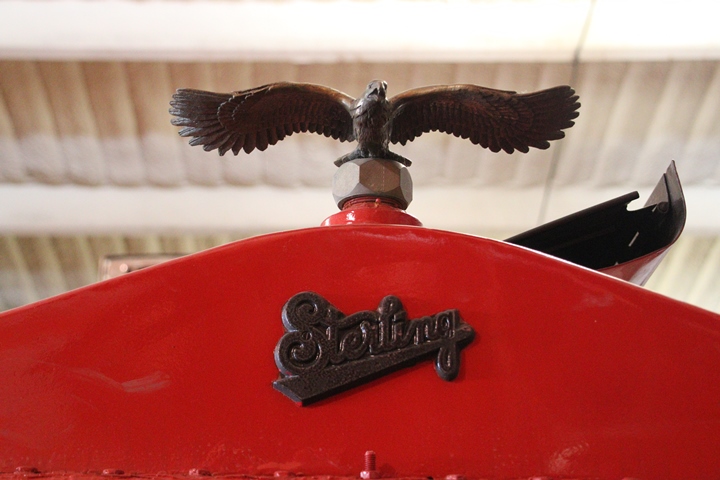
Author's photo added
1-12-2024.
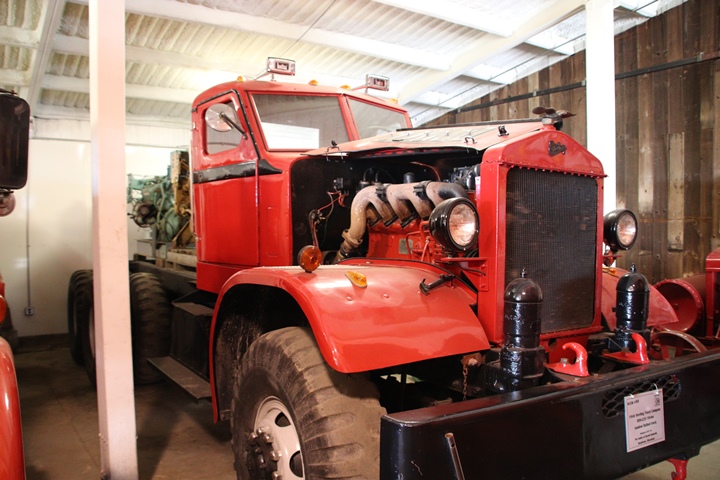
Author's photo added
1-12-2024.
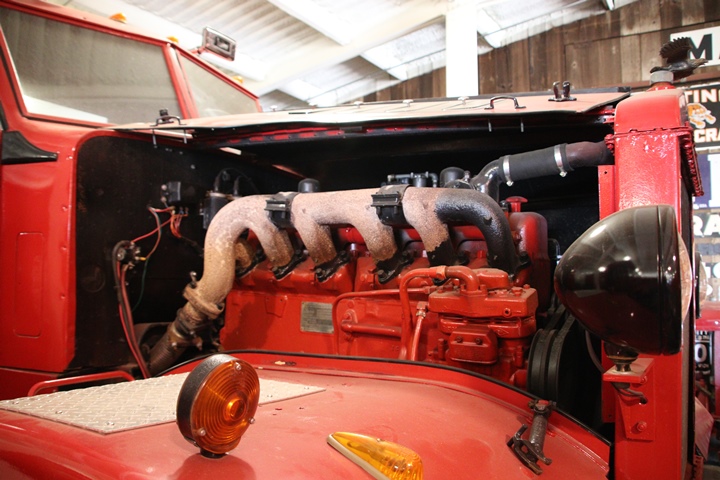
Author's photo added
1-12-2024.
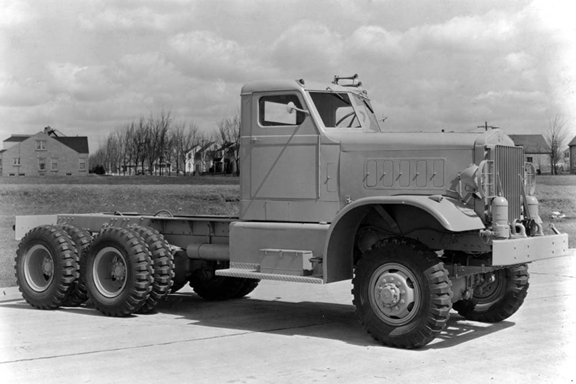
The Sterling DDS235 6x6 enclosed drive
(drive shaft) aircraft crash recovery vehicle was used by the U.S. Navy.
Photo courtesy of Jeff Lakaszcyck
added 11-13-2020.
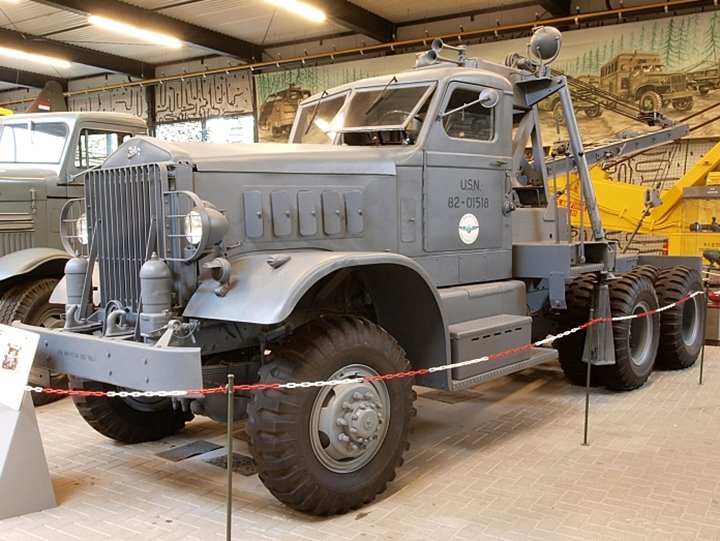
Today, Sterling trucks from World War Two are
extremely rare. This example of a DDS235 is on display at the Overloon Museum in the Netherlands. Photo courtesy of Alf van Beem.
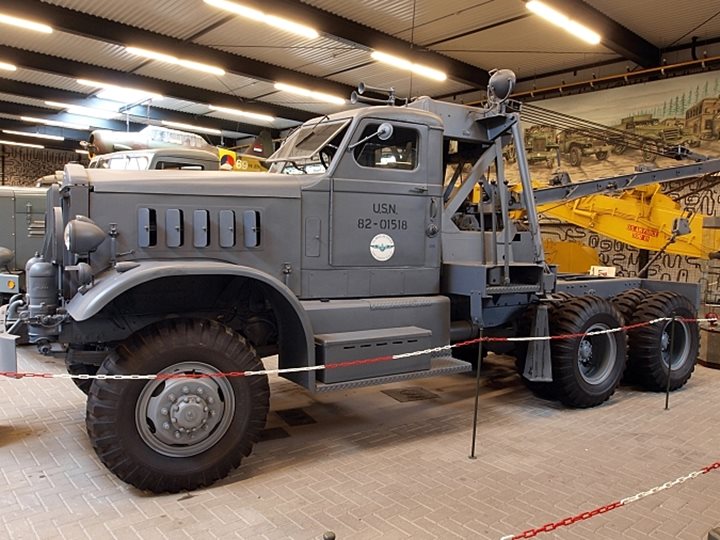
Photo courtesy of Alf van Beem.
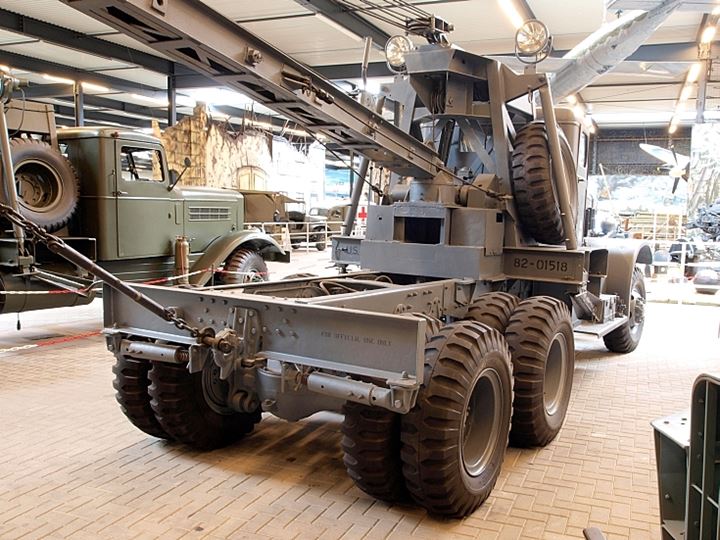
Photo courtesy of Alf van Beem.
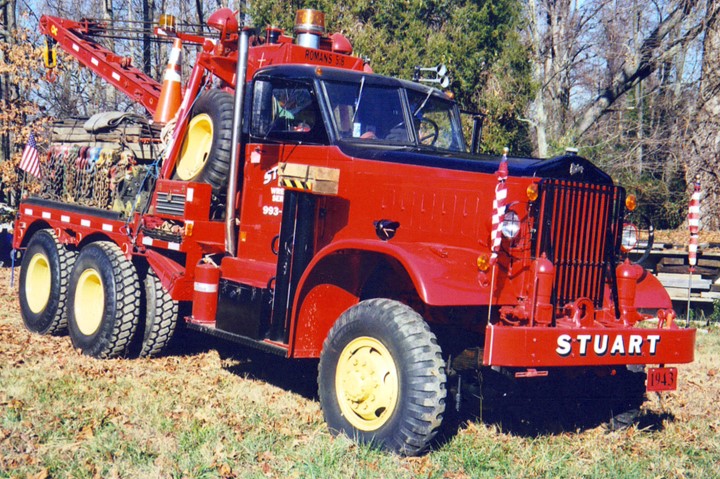
This 1943 DDS235 serial number 235DDS602 was
purchased as surplus military equipment in 1947 by the Stuart Wrecker
Service. It was in constant service with the company for 60 years
and is the best looking and well-maintained of the surviving DDS235s in
the United States. Photo courtesy of Jeff Lakaszcyck
added 11-13-2020.
DDS235 at the World War II American
Experience Museum: The Sterling DDS235 shown below is awaiting
restoration at the museum. I was able to photograph it during my
first visit to the museum. The truck will take considerable
restoration to return it to operating condition and make it look new
again. Doors will have to be found or fabricated as this truck
does not have any. However, the museum has been able to save this
rare Sterling truck. Once the truck has been found and saved, it
is a matter of time and money to restore it to its original
configuration.
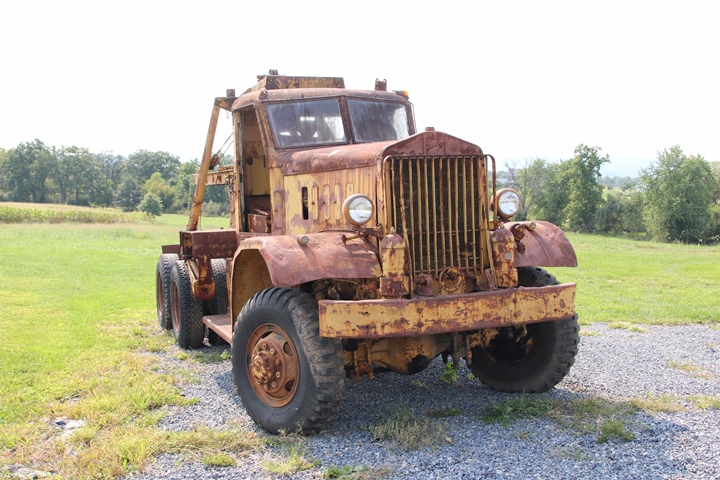
Author's photo added 1-12-2024.
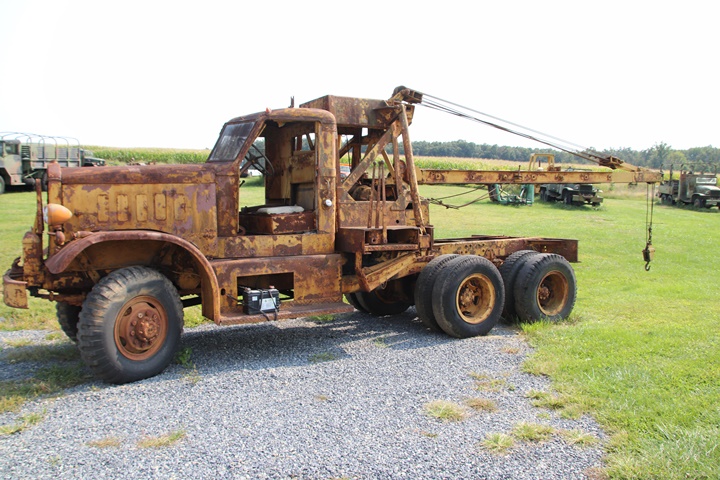
Author's photo added 1-12-2024.
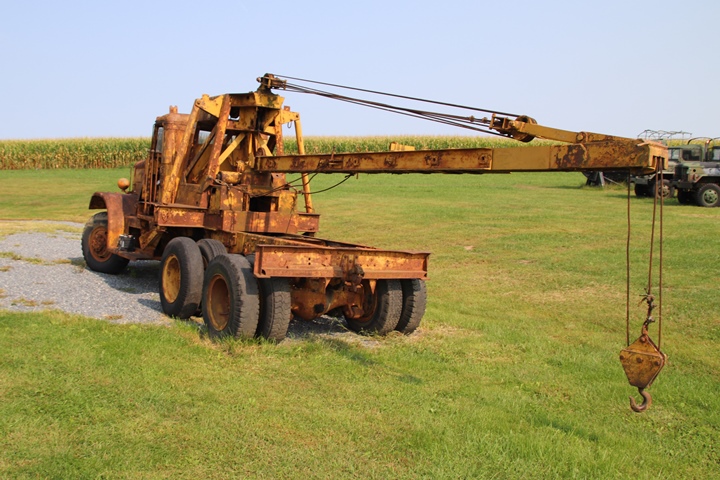
The wrecker unit on the DDS235 is a Gar Wood
3S6 T22. The boom is 18 feet long when retracted and 22 feet long
when fully extended. It appears to be in the fully extended
configuration. Author's photo added 1-12-2024.
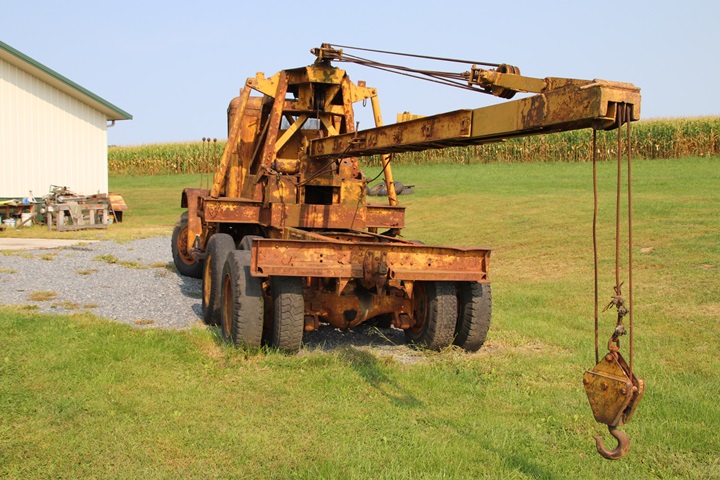
Author's photo added 1-12-2024.
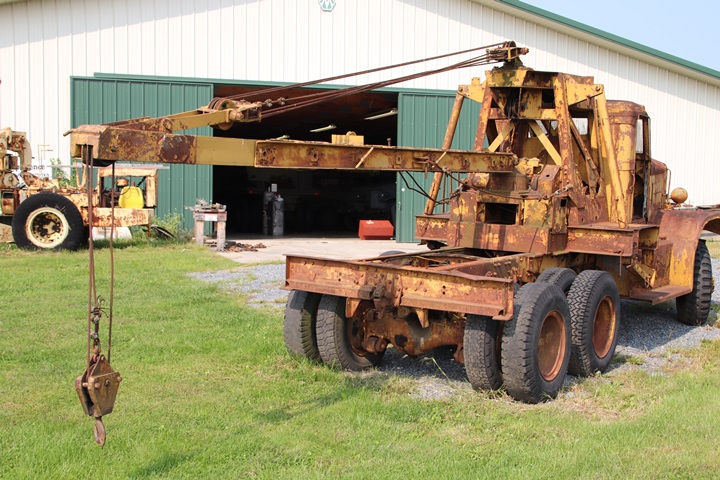
The U.S. Navy purchased 250 Sterling DDS235 wreckers for aircraft crash recovery
at its naval air stations. Author's photo added 1-12-2024.
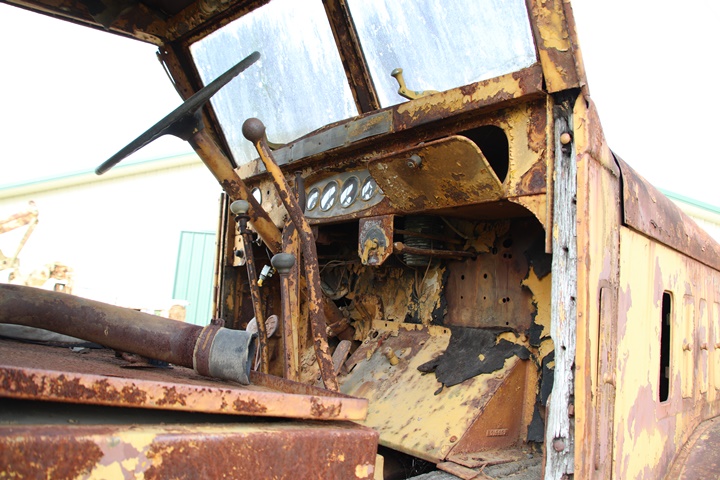
The next four photos show the condition of
the cab. Author's photo added 1-12-2024.
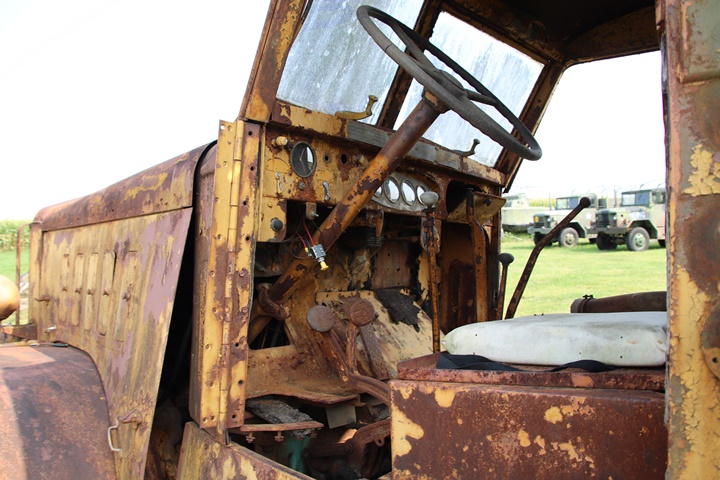
Author's photo added 1-12-2024.
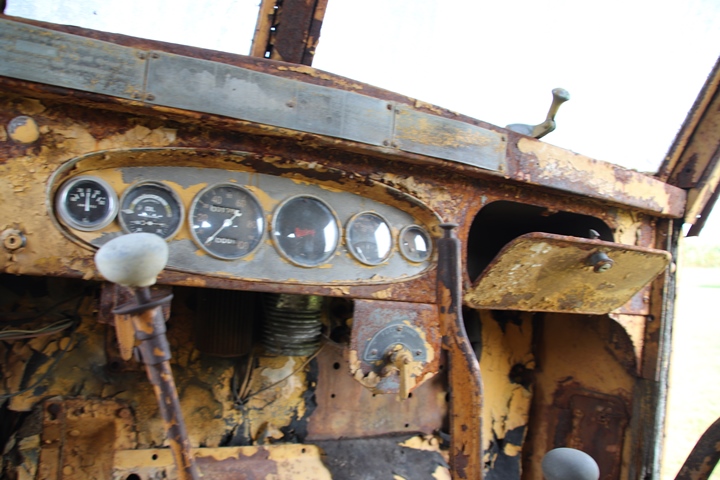
The instrument cluster is still complete.
Author's photo added 1-12-2024.
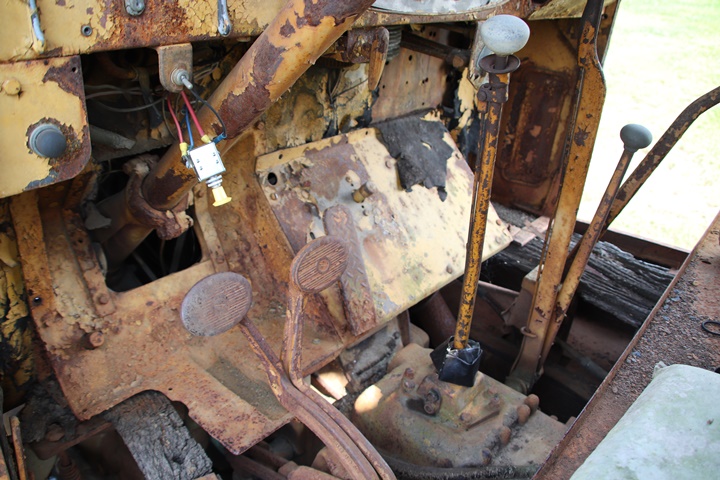
The floor board will need to be replaced.
Author's photo added 1-12-2024.
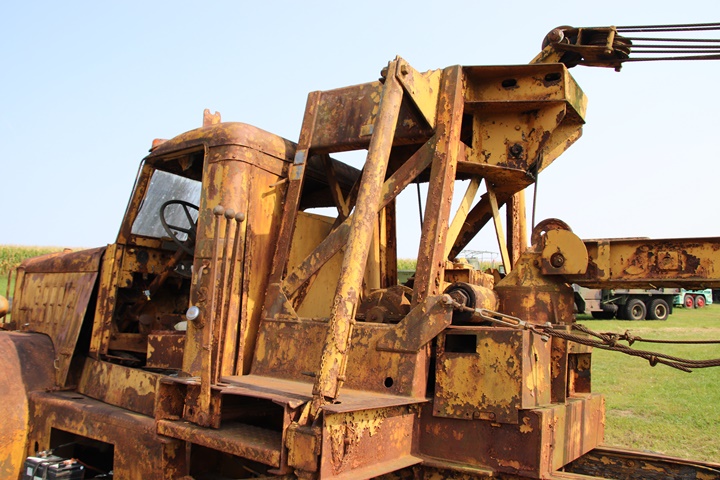
This and the next photo show the Gar Wood
3S6 T22 in more detail. Author's photo added 1-12-2024.
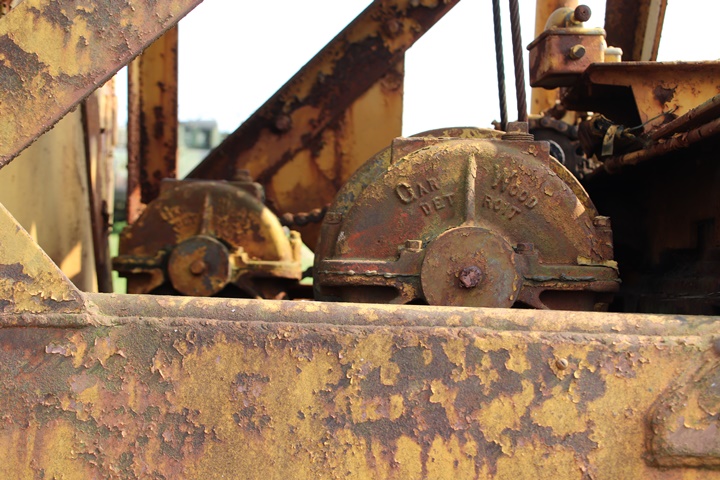
Author's photo added 1-12-2024.
DDS235 Serial Number DDS235-6139 at the Haul of Fame Museum in
Canterbury, CT:
 | |
Image courtesy of Phil Breault added
12-9-2024.

Image courtesy of Phil Breault added 12-9-2024.

This and the next photo have been provided
by Sterling truck historian Warren Richardson and show the DDS235 as it
was in 1975 at the City of New Bedford, MA airport. Image courtesy
of Warren Richardson added 12-27-2024.

Image courtesy of Warren Richardson added
12-27-2024.

This image shows the serial number that is stamped into the frame of the
truck. The serial number is 6139. Image courtesy of Warren Richardson added
12-27-2024.
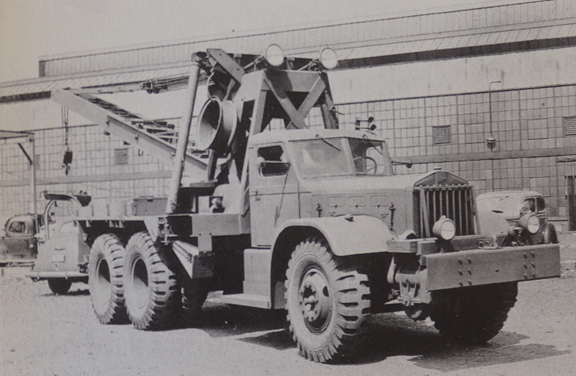
Sterling's HCS330 dual chain aircraft
recovery vehicle was used by the U.S. Navy for its bigger aircraft.

The largest land based US Naval aircraft,
like these Consolidated PB4Ys would need the Sterling HCS330 aircraft
wrecker to move them in an emergency.
Author's photo.
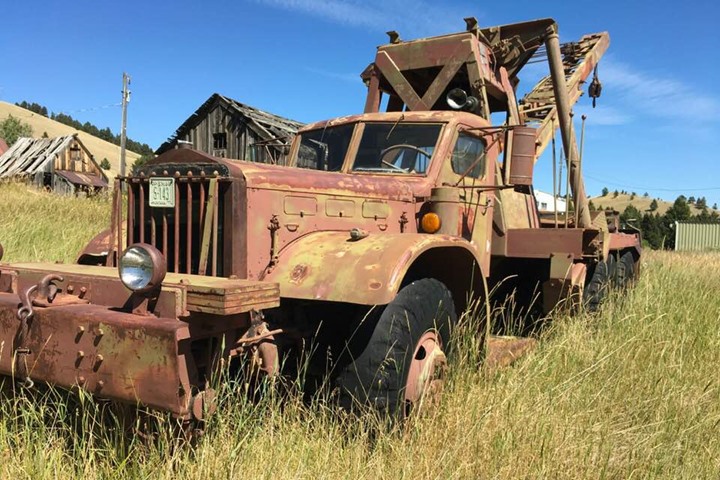
This is one of at least twelve known survivors of the 56
HCS330 heavy wreckers built for the U.S. Navy during World War Two.
It is sitting in a field in Marysville, MT. Photo courtesy of T.J.
Donahue via Jeff Lakaszcyck added 12-31-2020.
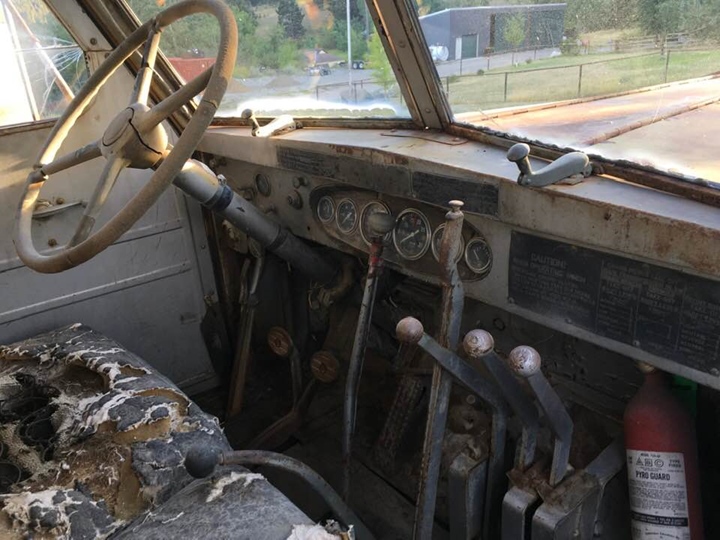
Photo courtesy of T.J. Donahue via Jeff Lakaszcyck
added 12-31-2020.
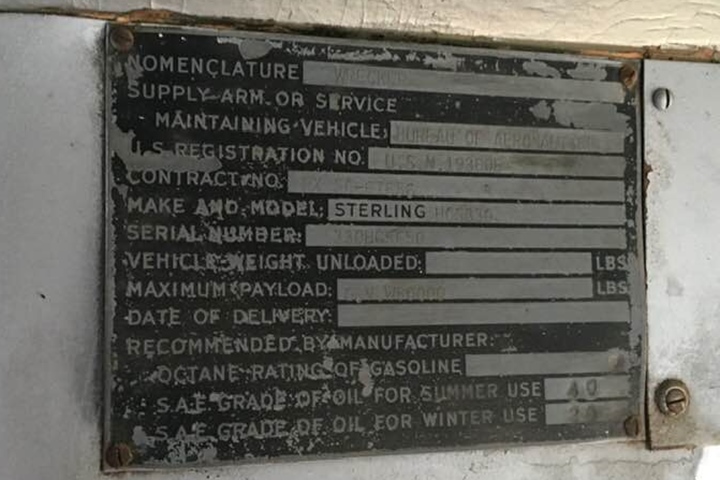
The data plate shows that this is U.S. Navy registration number 193806
and Sterling serial number 330HCST50. Photo courtesy of T.J.
Donahue via Jeff Lakaszcyck added 12-31-2020.
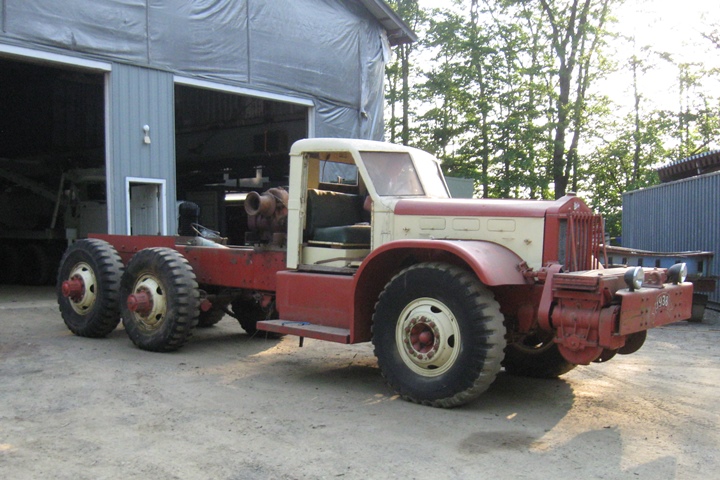
Ken
Ochenkowski is the owner of this HCS330. Photo courtesy of Jeff Lakaszcyck
added 1-3-2022.
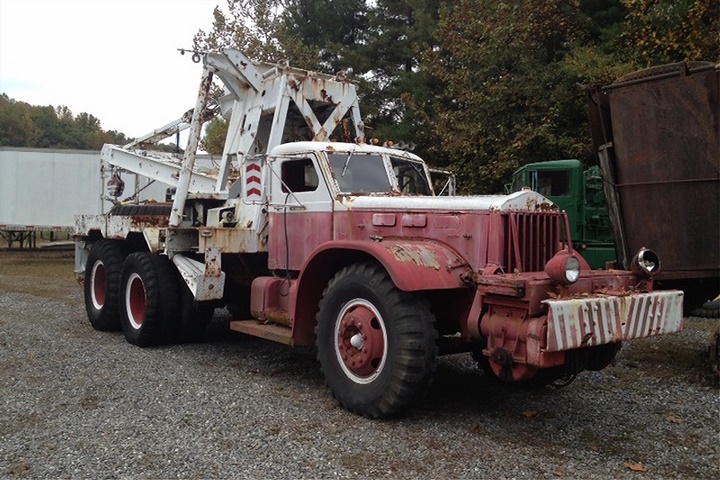
This HCS330 is owned by a private owner in
Virginia. Photo courtesy of Jeff Lakaszcyck
added 1-3-2022.
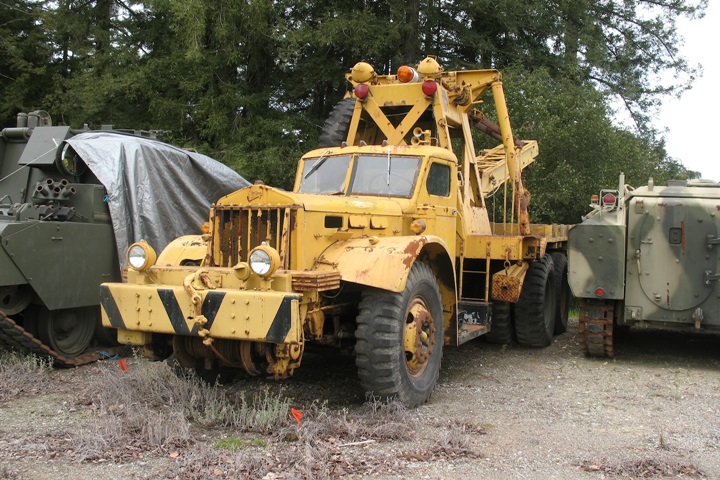
This HCS330 was in outside storage among some
armored vehicles of the late Jaques
Littlefield Collection. An unknown buyer purchased this truck at
the auction after Mr. Littlefield's passing. Photo courtesy of Jeff Lakaszcyck
added 1-3-2022.
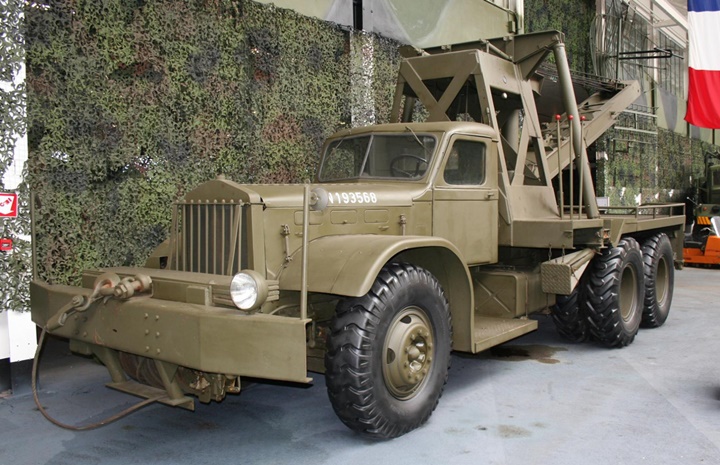
This Sterling HCS330 was photographed when
it was part of the collection at the Oorlogsmuseum at Overloon, The
Netherlands before being sold to a private owner. Photo courtesy
of Jeff Lakaszcyck
added 1-3-2022.
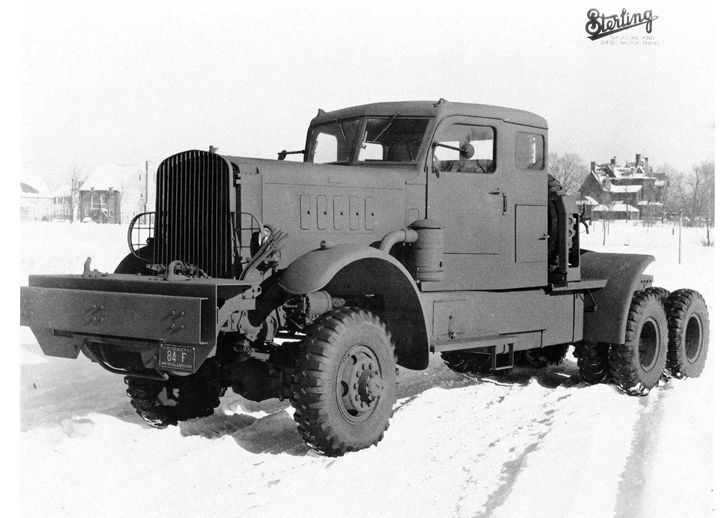
This Sterling 6x6 is described in U.S. Navy
literature as a Low Boy Tractor. It has an extended cab. Photo
courtesy of Jeff Lakaszcyck
added 11-13-2020.
Experimental Vehicles: Sterling
built twelve heavy-duty tractors at the end of World War Two and into
1946. They were designed to pull trailers with the new heavy tanks
the Army was beginning to produce. None ever entered into
production.
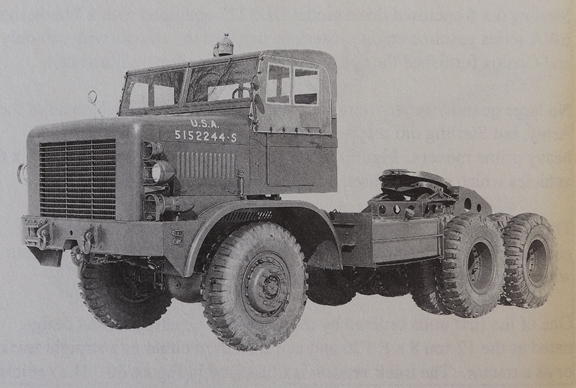
The 8-ton 6x6 T28 tractor shown here and the
T26 and T35 series of trucks below were experimental trucks ordered by
Army Ordnance. There is no record of Army Ordnance acceptances of either of these two types during
World War Two.
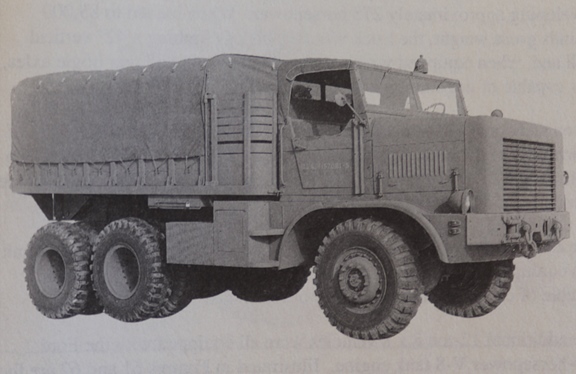
The Sterling 8-ton 6x6 T28
experimental truck.
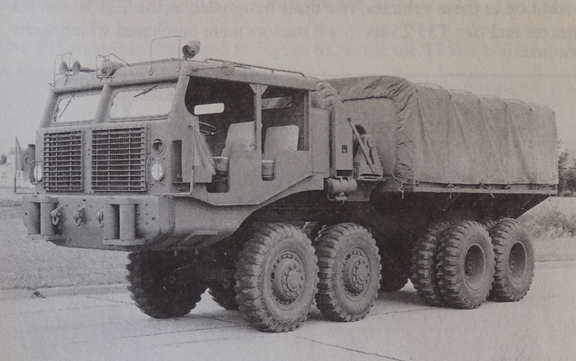
Another experimental Sterling vehicle
produced for Army Ordnance was the 12-ton 8x8 T26 Truck which had
additional crew space. In today's vernacular it is a crew cab.
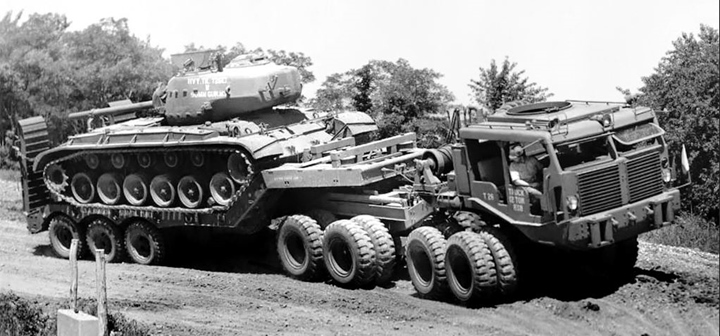
The T26 has been converted into a tractor
and is under test while pulling the trailer and light tank. Image
courtesy of Warren Richardson added 12-31-2020.
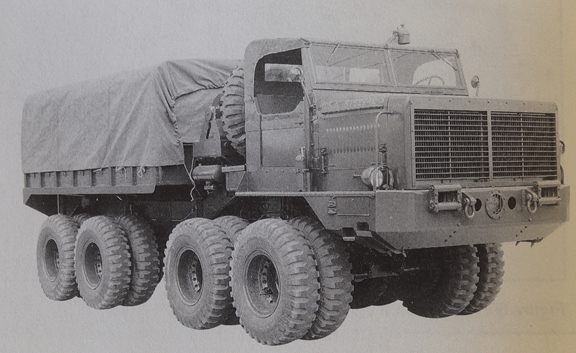
The 12-ton 8x8 T26E1 version of the truck does not have the
crew cab.
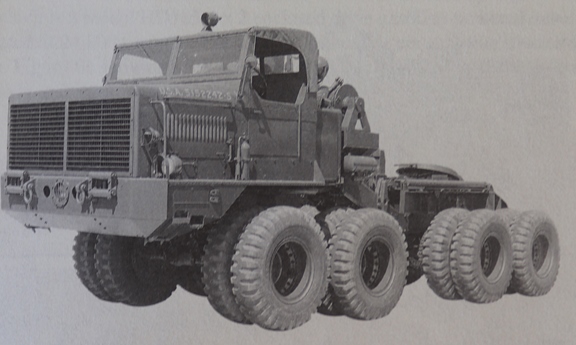
The Sterling 12-ton 8x8T26E1 Tractor.
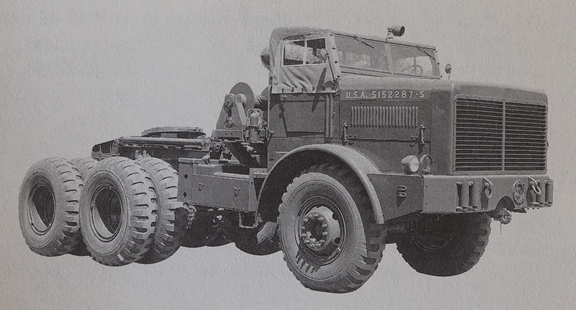
The
25-ton 6x6 T35 Tractor.
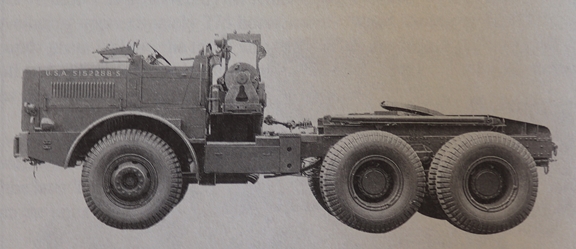
The
25-ton T35E1 Tractor.
Surviving Sterling World War Two Era
Trucks:
The 1944 HC165 Sterling tractor shown below is owned
by John Gott. This was one of five HC165s that were used by the
U.S. Navy in World War Two. It is the only one that has survived.

Photo courtesy of Jeff Lakaszcyck
added 10-26-2020.
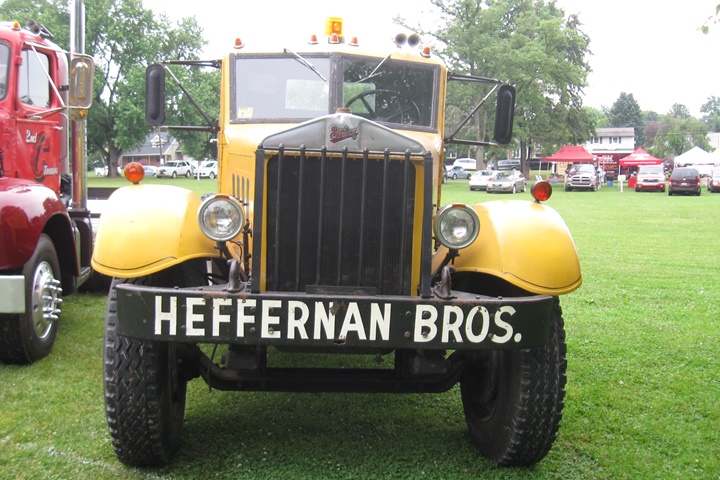
Photo courtesy of Jeff Lakaszcyck added
10-26-2020.
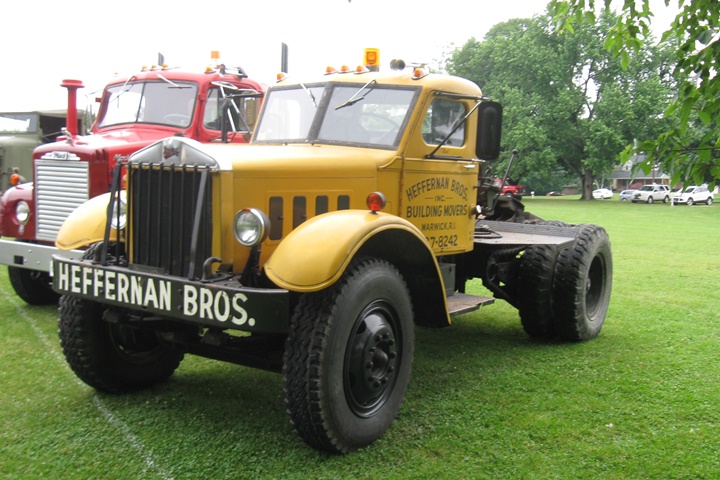
Photo courtesy of Jeff Lakaszcyck added
10-26-2020.
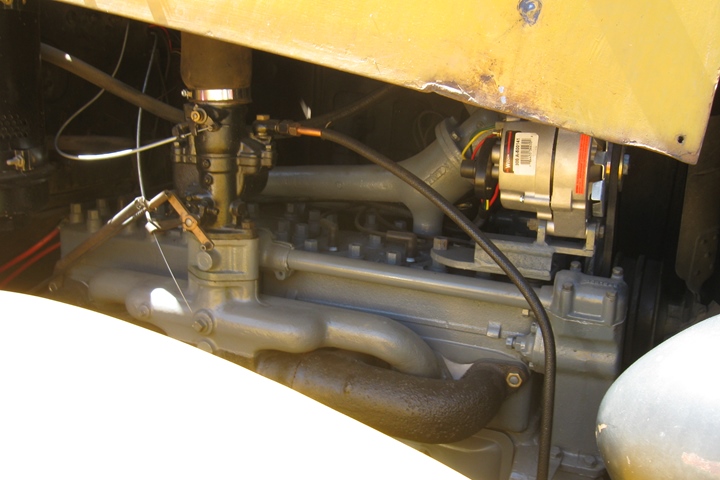
Photo courtesy of Jeff Lakaszcyck added
10-26-2020.
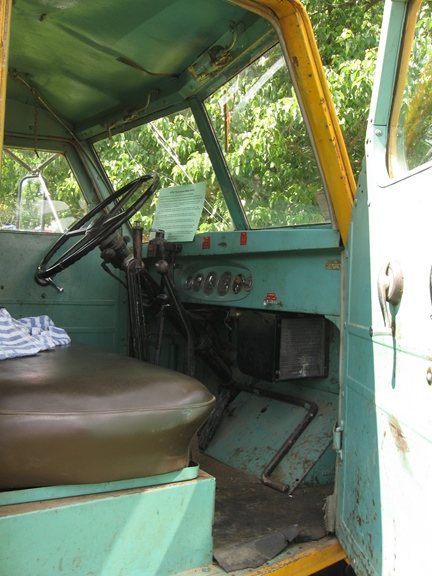
Photo courtesy of Jeff Lakaszcyck added
10-26-2020.
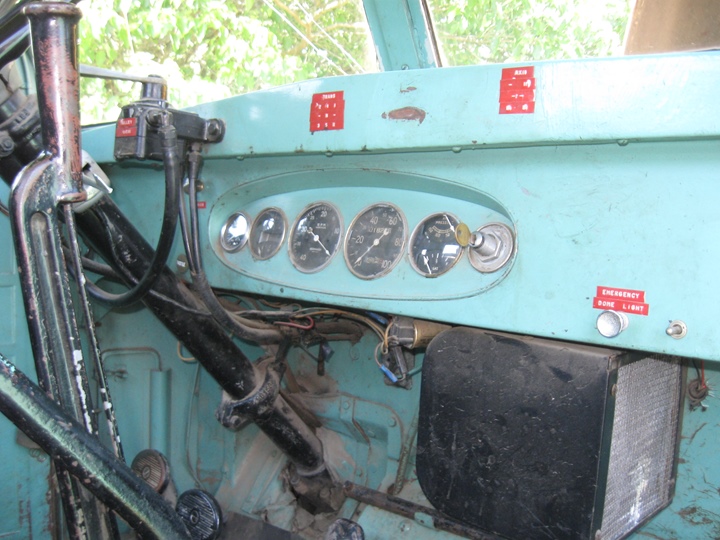
Photo courtesy of Jeff Lakaszcyck added
10-26-2020.
The 1947 HCS297H Sterling tractor shown below is owned
by a private owner in Maine. The U.S. Army Corps of Engineers used some of
this type of civilian truck in Alaska.
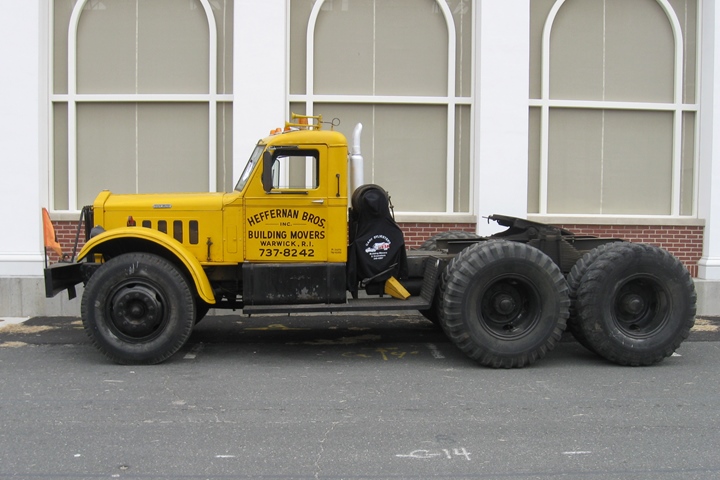
Photo courtesy of Jeff Lakaszcyck added
10-26-2020.
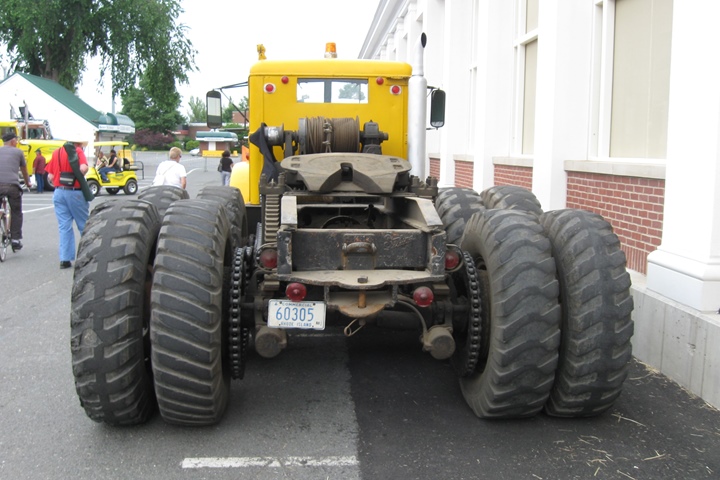
Photo courtesy of Jeff Lakaszcyck added
10-26-2020.
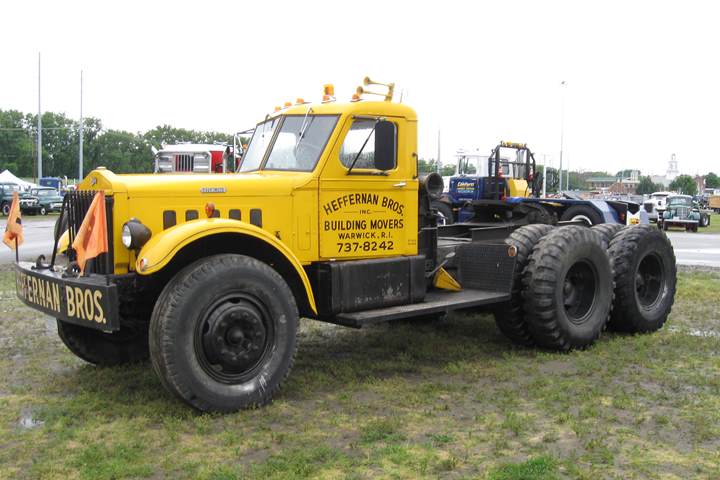
Photo courtesy of Jeff Lakaszcyck added
10-26-2020.

Photo courtesy of Jeff Lakaszcyck
added 10-26-2020.
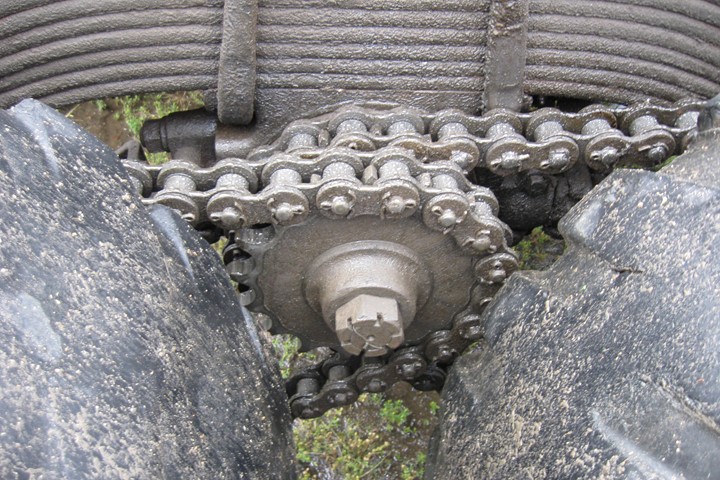
Photo courtesy of Jeff Lakaszcyck added
10-26-2020.
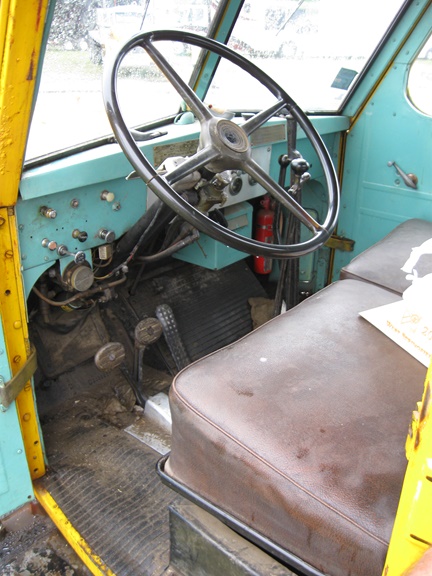
Photo courtesy of Jeff Lakaszcyck added
10-26-2020.
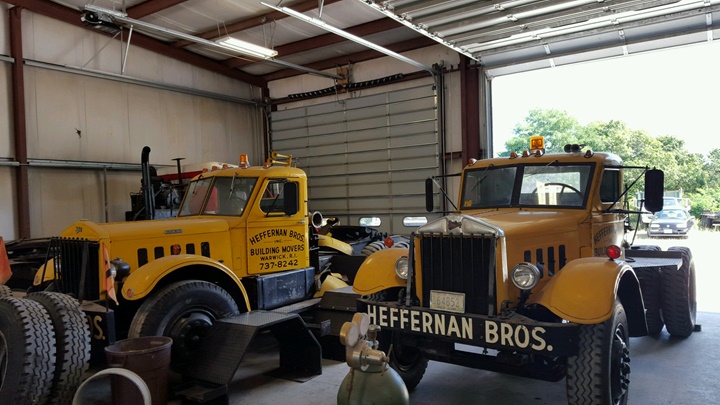
This photo was taken 2015 in Gary
Sylvester's garage. It was the last time the two trucks were together. Ken Ochenkowski
photo via Jeff Lakaszcyck added 10-26-2020.

This derelict DDS225 was photographed in the
woods by the late Daryl Gushee and is the only known survivor of the
series. Photo courtesy of Jeff Lakaszcyck added 11-13-2020.
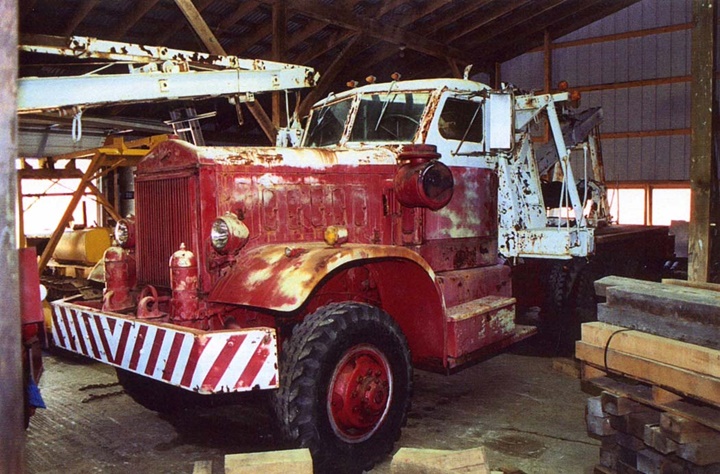
This photo of a former Cardox DDS235 that was converted into a wrecker
is owned by a private owner in Virginia. Photo courtesy of Jeff Lakaszcyck added 11-13-2020.
The Sterling Motor Truck Factory in West
Allis, WI: Sometimes things just work out. I had just
published my 1-17-2024 update of this page and realized I did not know
the location of the Sterling factory. Therefore, on 1-18-2024, I
asked Sterling historian Warren Richardson via email whether he had any
information on this.
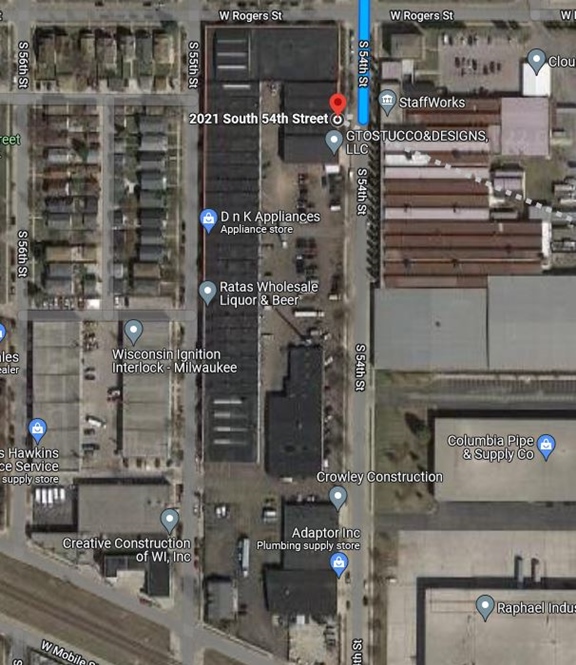
In his first reply, he sent this Google Satellite image. The
mystery appeared to be solved. Sterling Motor Truck Company had a
factory that ran between South 54th and 55th Streets, south of West Rogers
Street in West Allis, WI. The address for the plant was 2021 South
54th Street. Image added 1-28-2024.

Later the same day, Mr. Richardson sent this
and the image below that he had found in his records. This
artist's drawing is from a Sterling advertising brochure for one of its
1940s era trucks. While the artist took some liberty with the width of
the complex, the layout matches up with the previous Google Maps image.
Note how well the roof of the building in the upper right of this
drawing
matches the roof in the satellite view above. With the two doors
that open on to the driveway, this may have well been where the new
trucks exited the factory. The Google Maps Satellite image above
shows that the driveway area later became factory space. Image
courtesy of Warren Richardson added 1-28-2024.
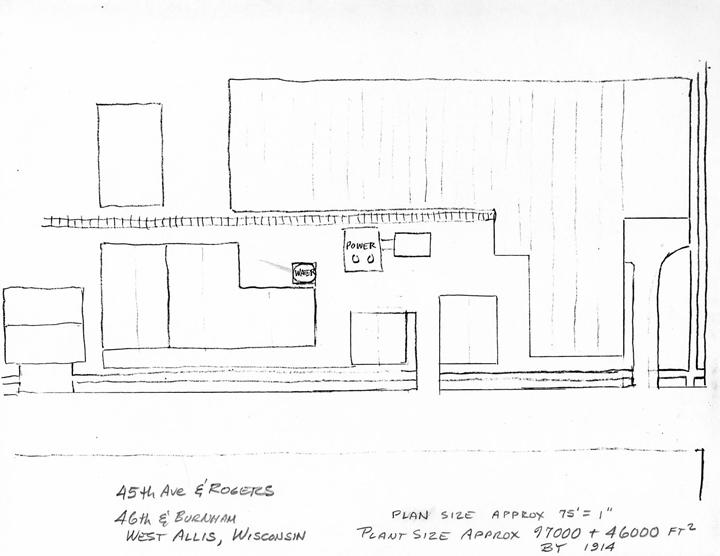
In the same email, Mr. Richardson also
included this hand drawing he made that shows the same layout as shown in the
previous two images. What was confusing was that the location was
given as 45th and Rogers and/or 46th and Burnham in West Allis, WI.
The current location for the factory is at Rogers and South 54th Street,
not South 45th Street. For some reason, the street numbers changed
over the years. Mr. Richardson and I were trying to understand why
this had happened. Image courtesy of Warren Richardson added
1-28-2024.
This is where fate stepped in.
Unbeknownst and independent of our research, Mr. Julian Erceg was also
researching this same topic. Mr. Erceg grew up in West Allis, WI
during the 1970s and 1980s and was aware of the former Sterling factory.
However, he did not know that this particular building was the former Sterling plant, as the
factory closed in 1951. He even had a girl friend that lived
across the street from the former factory on South 55th Street!
As Mr. Erceg was currently researching this, he also
found my website and contacted me on 1-20-2024. Below is the
information he sent.
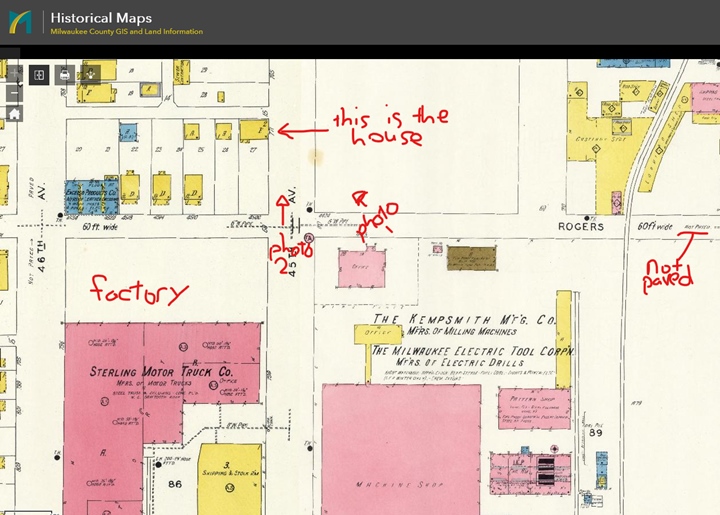
Mr. Erceg's research led him to this
1927 Sanborn Map, which he marked up and sent to me. First of
all, it shows that the location of the factory was at Rogers between 45th
and 46th streets. In 1927 it should be noted that the building on
the northwest corner of the factory complex
shown in the artist's drawing above has not yet been added. Also,
he marked the location of the house in the 1918 photo. His marking
"this is the house" is the one shown in the 1918 photo below.
Image courtesy of Julian Erceg added 1-28-2024.
In the photo below, the Liberty trucks shown
in front of the house were on 45th street north of Rogers Street and
north of the Sterling factory. The photo also shows that Rogers
Street was not paved east of 45th Street, as Mr. Erceg has pointed out
on the Sanborn map.

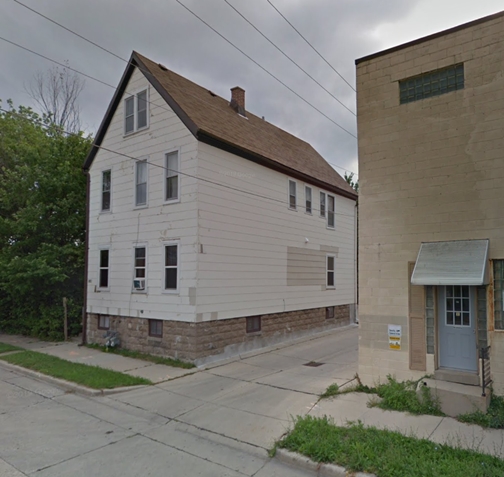
He also included this Google Maps street
view to show what it looks like over 100 years later. Image
courtesy of Julian Erceg added 1-28-2024.
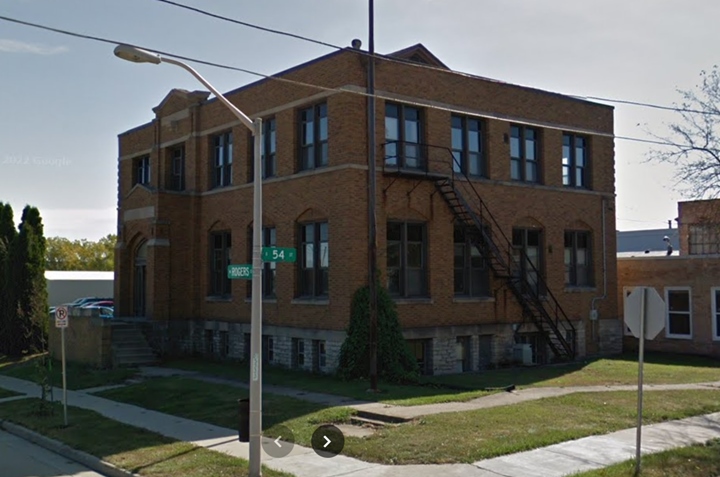
Mr. Erceg also has an arrow pointing north
and labeled "photo 1." The Sanborn Map shows this building at this
location. This was the office building for the Kempsmith
Manufacturing Company. The photo was taken from the roof of this
building. Google Street map image added 1-28-2024.

This is "photo 2" as noted on Mr. Erceg's
Sanborn Map.
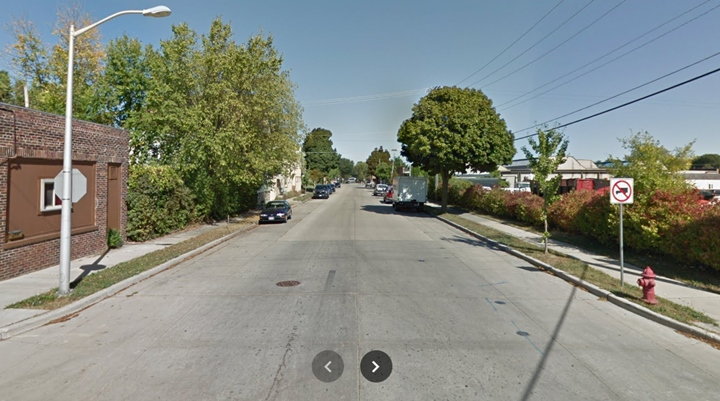
This is the former 45th Street, now 54th
Street, looking north from Rogers Street. This is the location of
the Liberty trucks in above photo. Google Street map image added
1-28-2024.
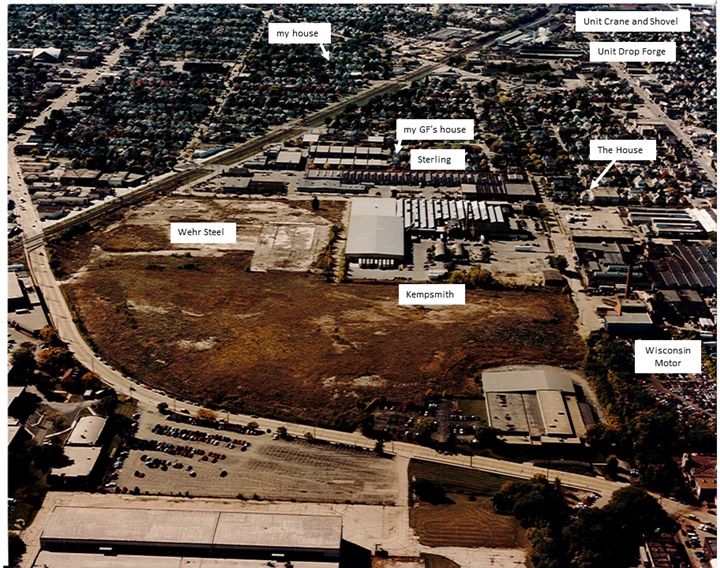
Mr. Erceg also included this 1996 aerial map
that shows the West Allis, WI that he grew up in. The location of
the house he grew up in is labeled "my house." His
girlfriend's house is labeled "my GF's house." Also noted is the
house from the 1918 Liberty truck photo. It is labeled "The
House." This image is courtesy of the Milwaukee Historical Society.
It was added 1-28-2024.
Next is the complete 1927 Sanborn map of the
Sterling Motor Truck Company.
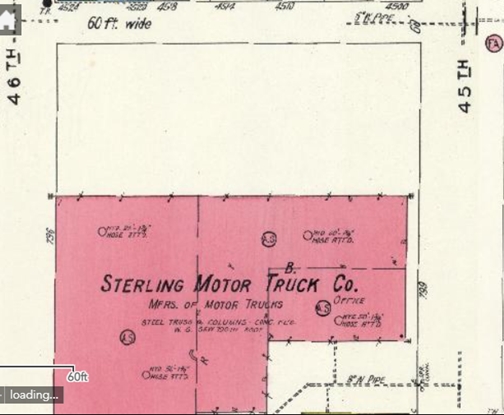
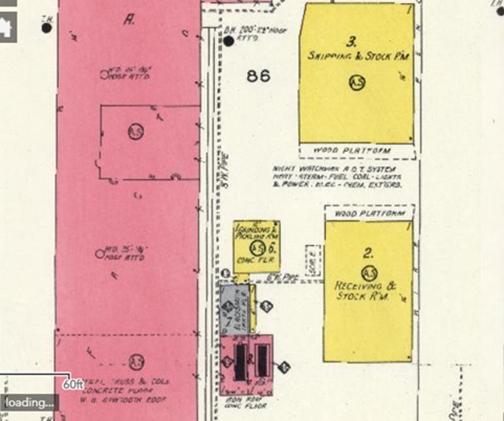
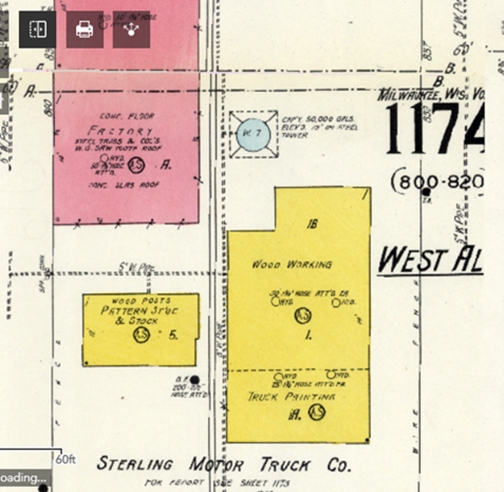
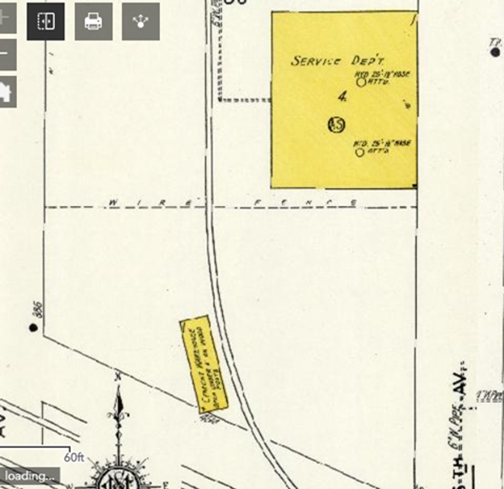
Note the Service Department building in the
lower right hand corner of the map. We will see it again.
Image added 1-28-2024.
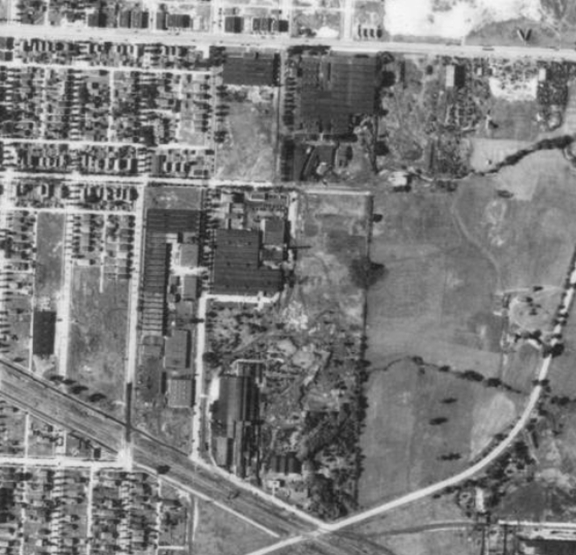
This USDA aerial photo shows the Sterling
Motor Truck Company factory in 1937. Image courtesy of Wisconsin
Historical Image Finder added 1-28-2024.
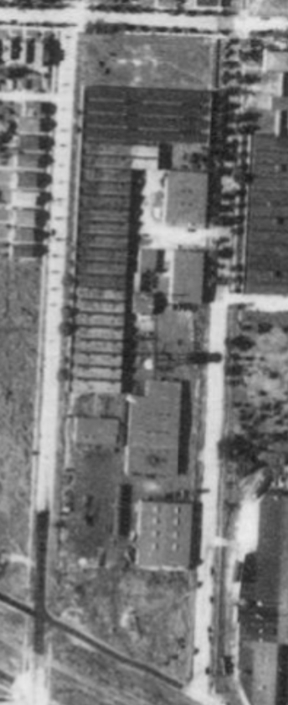
Image courtesy of Wisconsin Historical Image
Finder added 1-29-2024.
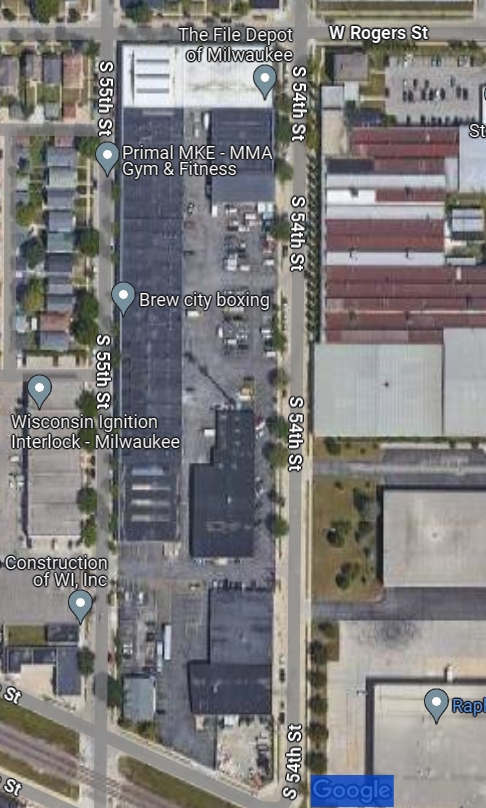
The length of the former Sterling Motor
Truck factory along South 55th Street is 801 feet. The width of
that portion of the factory is 100 feet. This includes the length
of the building in the northwest corner with the white roof that was not
on the 1927 Sanborn Map nor the 1937 USDA map. The length of the
original factory building with the black roof is 700 feet. Image
courtesy of Google Maps added 1-28-2024.
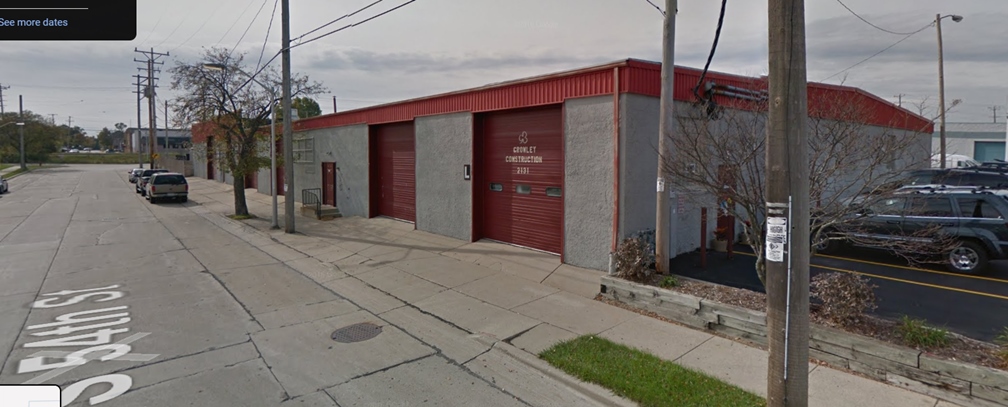
This is the former Sterling Service
Department. In 2016 it was the home of a construction company.
All of the former Sterling factory buildings have been painted gray with
red trim. One would never know this or the other buildings in the
complex are over 100 years old. Image courtesy of Google Maps
added 1-28-2024.
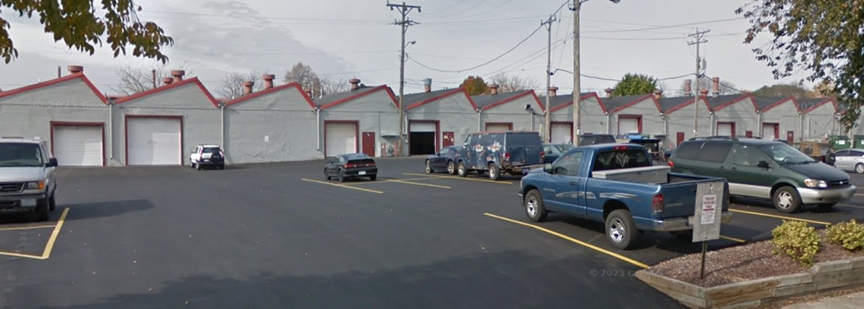
This image shows the east side of the 700
foot long building complex. The buildings still have their
distinctive saw tooth roofs. Image courtesy of Google Maps added
1-28-2024.

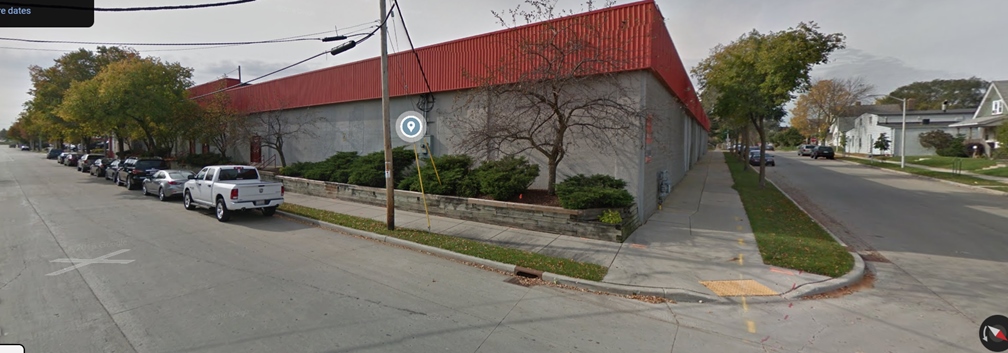
This is the northeast corner of the complex
at the corner of South 54th and Rogers Streets. This building was
added after 1937. The earlier artist's rendering of the plant
showed trees along the street in front of the plant.
There are still trees on the east and north sides of the building.
The red trim, gray painted walls, and shrubbery hide the fact that this was a
former truck plant. Image courtesy of Google Maps added 1-28-2024.
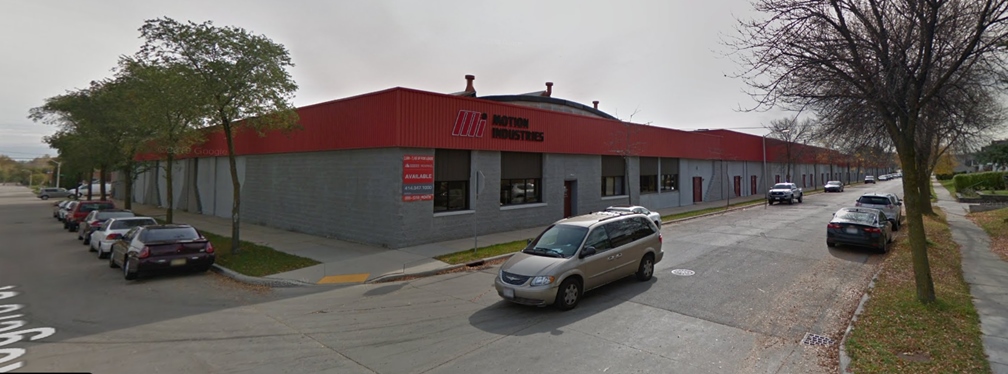
This building at the corner of South 55th
and Rogers Streets was also added after 1937, even though it is shown in
the artist's rendering. It does not have the saw tooth roof but a
domed roof that can be seen in this photo. The red trim along the
top of the buildings along 55th Street hide the saw tooth roofs.
Image courtesy of Google Maps added 1-28-2024.
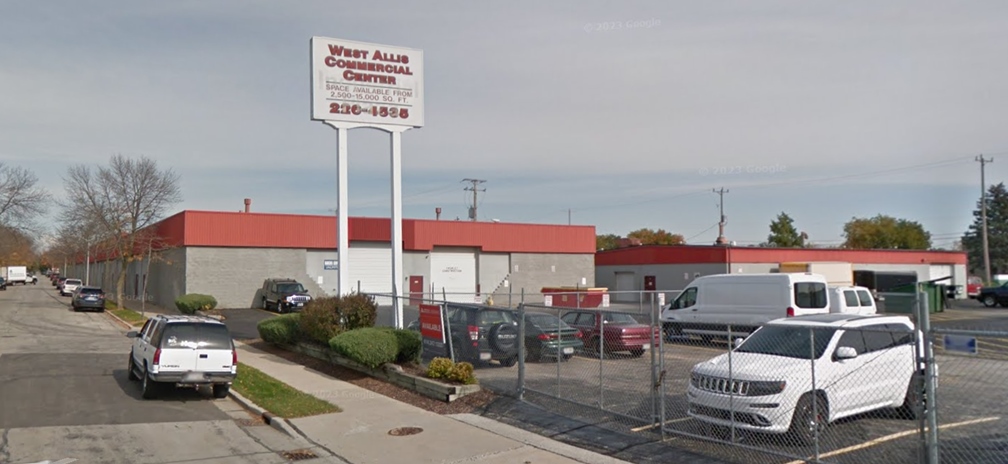
The former Sterling Motor Truck plant is now
the West Allis Commercial Center. Image courtesy of Google Maps
added 1-28-2024.

Mr. Erceg's girl friend lived in one of the houses in this image.
He noted in one of his emails that there was an old building across the
street but they did not know what
it had been. No doubt it did not look as good as it does now.
Image courtesy of Google Maps added 1-28-2024.
|




























































 |
|
























































